
Roadmap Examples To Help You Make Better Roadmaps Faster
This blog showcases the best examples of roadmaps in specific categories, including:
- Product Roadmaps
- Project Roadmaps
- Program Roadmaps
- Project Portfolio Roadmaps
- Strategic Roadmaps
- IT Roadmaps
- Marketing Roadmaps
In each section, you will also find links to guides to help you create specific kinds of roadmaps and Visor templates to help you get started faster with an AI-generated roadmap in Visor, which is one of the best roadmapping tools available.
You can create every type of roadmap using Visor, an easy-to-use project, program, and portflio visualization tool that integrates with Jira, Asana, Salesforce, and other apps. Use it to create high-quality roadmaps that delight your stakeholders. Try Visor for free now.
What is a roadmap?
A roadmap is a visual representation of a plan that usually shows the work required to complete a project, set of projects, or larger initiative.
Roadmaps can come in a range of formats; the most common is a linear Gantt chart or timeline format.
However, some teams—particularly those following agile project management methodologies—opt for a Kanban board-based roadmap without a linear, date-based structure or strict start and due dates for tasks.
Roadmaps help people to:
- Plan and schedule work items
- Avoid scheduling and resource conflicts
- Show dependencies between tasks and projects
- Align stakeholders with a clear view of what will be done and when, by whom
What is the most common roadmap format?
Most people create roadmaps using a Gantt chart or timeline format, with work items (such as initiatives, tasks, and subtasks) represented as bars or project milestones, each having clear start and end dates.
An example of a Gantt chart style roadmap created in Visor:
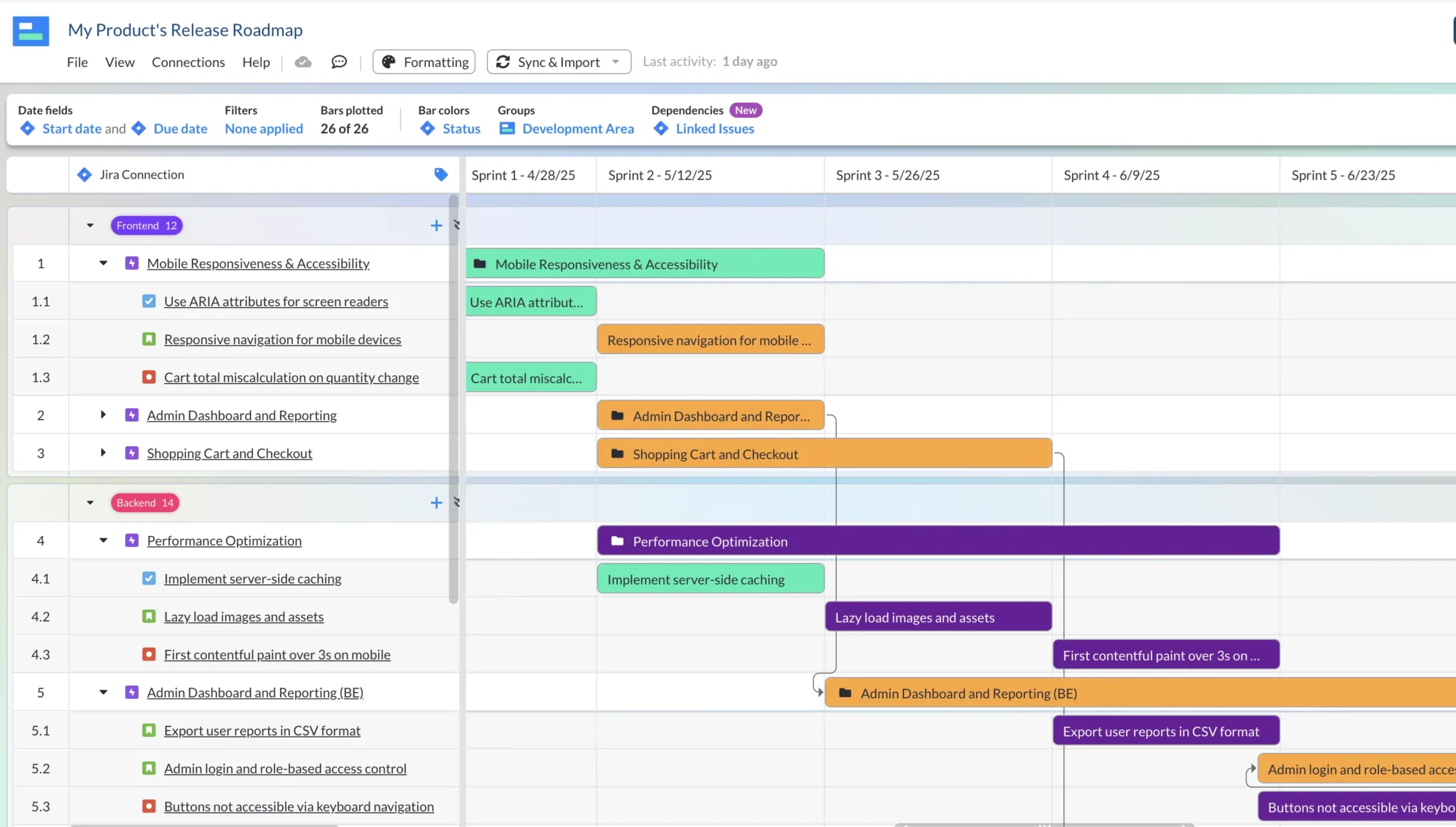
Some people reject this linear timeline format and instead use a simple “Now, Next, Later” format. Each of these three stages or timeframes is represented either as columns in a table or on a Kanban board.
Initiatives or tasks are placed in each of these buckets and move between them as their status and priority change; for example, a task moves from the Next column to the Now column when the team is ready to work on it.
An example of a Kanban Board roadmap created in Visor:
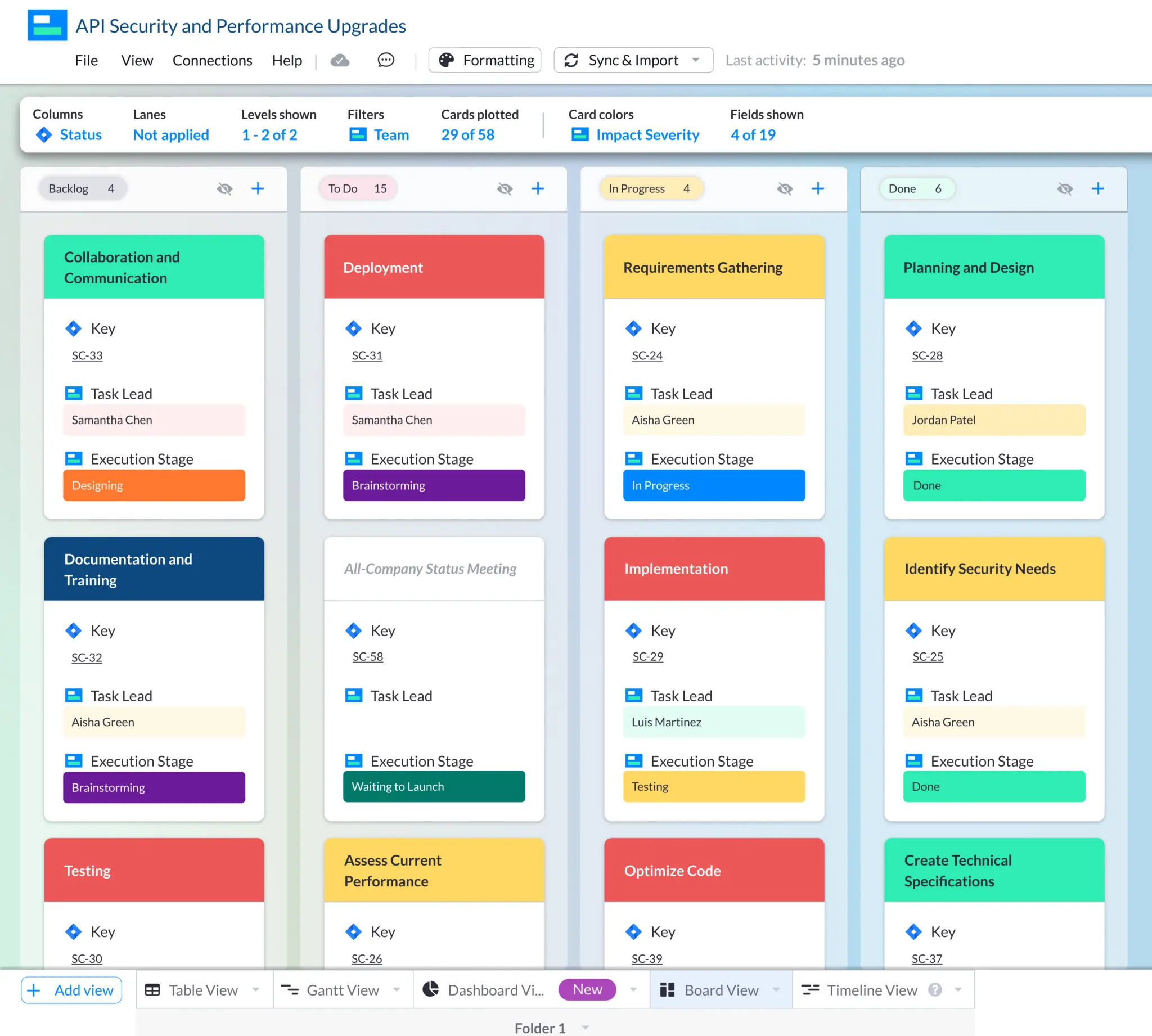
Can You Create Roadmaps Without Start and End Dates?
You can use a Kanban board or table to create a roadmap without clear start and end dates and instead use buckets or columns for periods, the most common being “Now, Next, Later”.
This offers a more agile approach that allows teams to prioritize and sequence their work without strict start and due dates.
Now, Next, and Later are just one set of stages that you can use; other examples include:
- Planned, Research, In progress, Launched
- Someday, Later, Next, Now
- Future, Soon, Next, Immediately
Product Roadmap Examples
Product roadmaps are a crucial component in successful product management. They enable product managers, product owners, and individuals in similar roles to visually communicate their product’s vision and create a viable, realistic plan for achieving it.
Product roadmaps created using product roadmapping software provide product managers with a way to view, track, adjust, and update their product plans, which is much easier, more flexible, and faster than using a product planning document.
Product roadmaps and project roadmaps share many similar components; to avoid confusion, I have summarized the key differences between them. You can find this summary after the examples of product roadmaps below.
Example of a Simple Gantt-Style Product Roadmap
A product roadmap created in Visor using real-time Jira data with milestones and a column for task status, with tasks grouped by initiative:
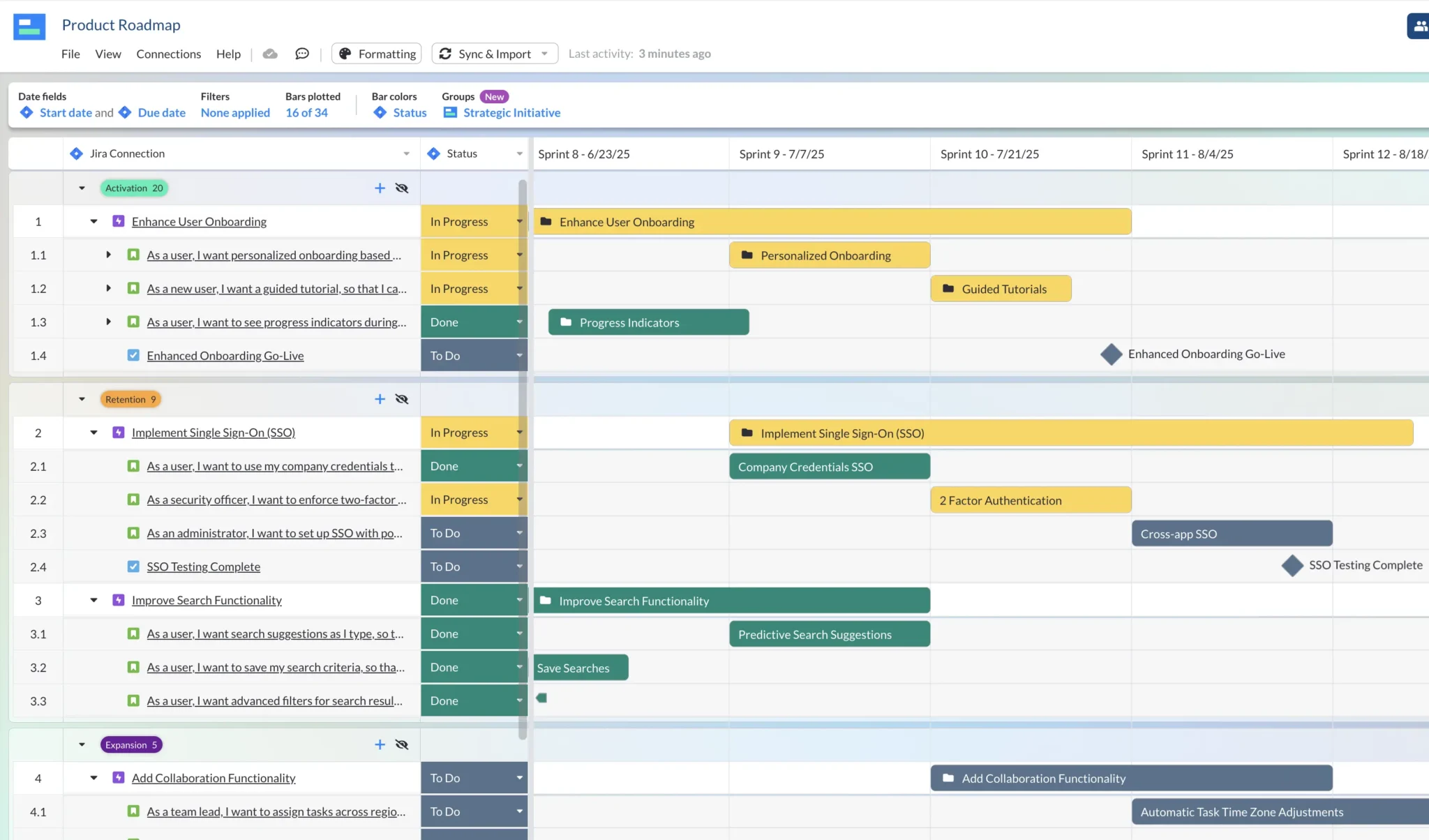
Example of a Product Roadmap With Cross-Project Dependencies
A product roadmap using real-time Jira data and created in Visor. Jira issue links (dependencies) are shown both within projects and across projects too, enabling the user to identify potential blockers and prevent delays.
Tasks are grouped by their project. Note the neat and ordered nesting of epics, stories, and subtasks:
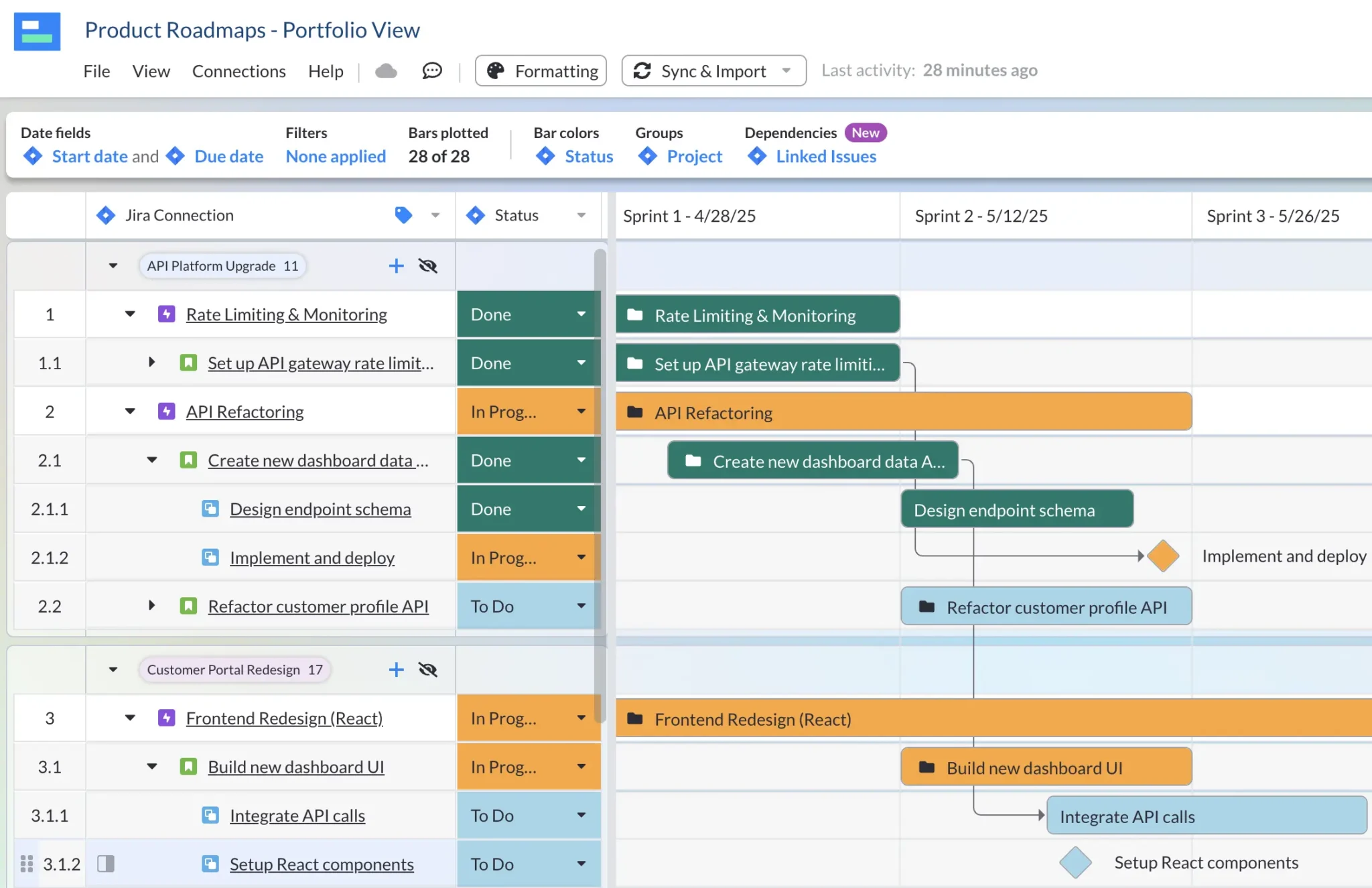
Example of a Kanban Board Product Roadmap
Here is a Kanban Board style product roadmap created using Visor’s Kanban board view:
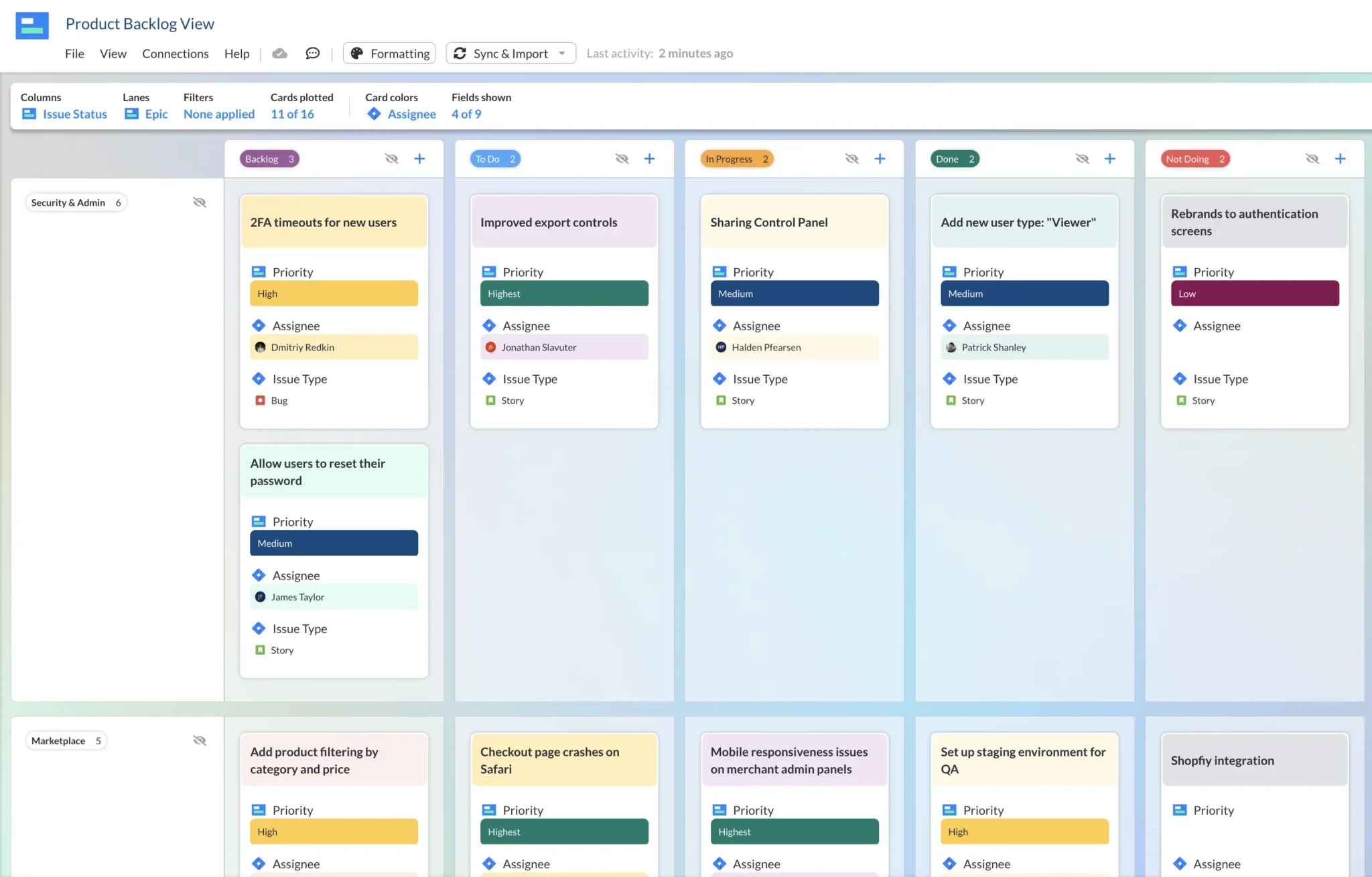
Example of a Timeline Product Roadmap For Multiple Products
Here is a simple timeline product roadmap, featuring tasks across multiple products, with swimlanes for each product and additional rows within those swimlanes for the team responsible for each task:
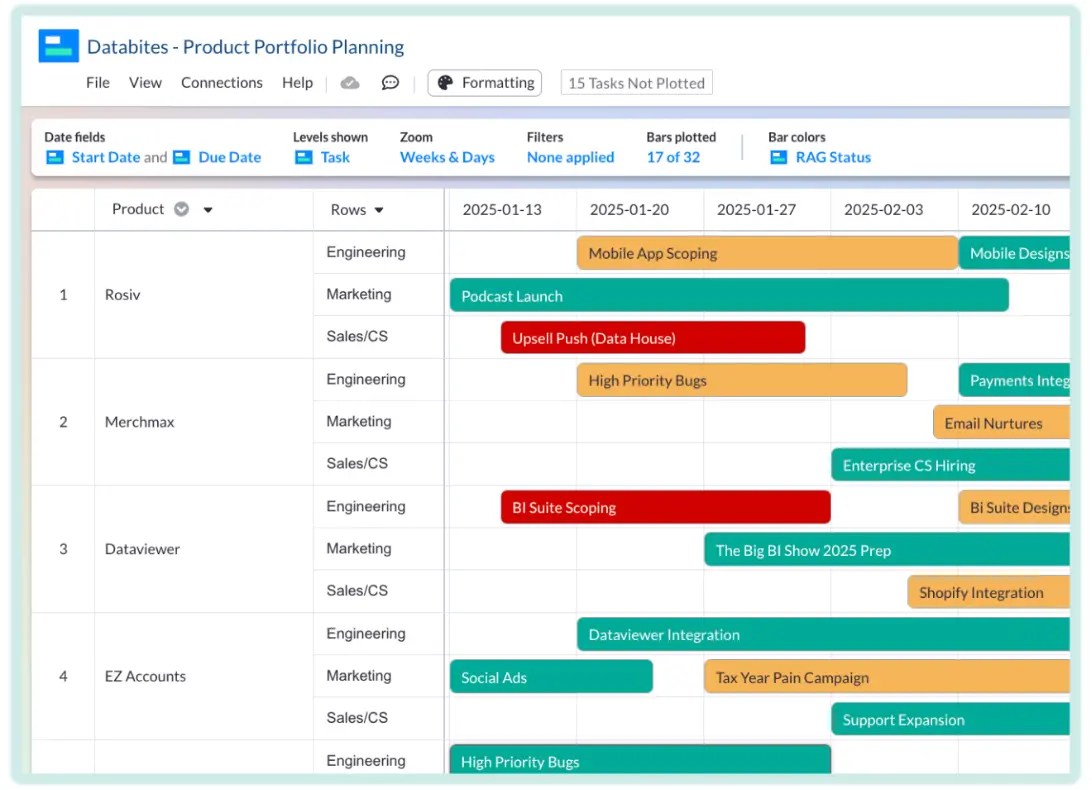
What common features do the best product roadmap examples share?
The best examples of product roadmaps all share common features and characteristics, which include:
- Clear status and progress indicators: Typically supported by color-coding to enable viewers to see the status of different projects and tasks at a glance
- Tailored to specific audiences: Product managers will create different views of the same roadmap with the appropriate level of information, timescale, and detail for specific stakeholders
- Labeling and categorization: Product roadmaps contain multiple initiatives and features with layers of tasks. Adding labels and other information to each item enables users to categorize, group, and filter their product roadmap views.
- Milestones: Usually represented as a diamond symbol on the roadmap, milestones are key moments in a product roadmap that are crucial to a specific initiative or project’s success
- Interactivity: Product roadmaps work best when users can interact with them, switch between detailed and high-level views, focus on specific work types, tasks for specific teams, and so on.
- Organization and Grouping: Product roadmaps can easily become overwhelming. Adding sensible groupings and layers of organization (including nesting and grouping by initiative or project) ensures people can take a high-level view and drill down as required
Learn more about how to create best practice product roadmap visualizations.
How do product roadmaps differ from project roadmaps?
Product roadmaps share many characteristics with project roadmaps – such as product roadmap milestones, which are essentially the same as project milestones. However, the overall scope and purpose of product roadmaps and project roadmaps differ significantly.
Firstly, product roadmaps can be continuously evolving and ongoing, unlike a project roadmap, which has a clear start and end date.
Secondly, product roadmaps typically encompass multiple separate projects that collectively contribute to the development of a single product. For example, a product roadmap for a dating app may include initiatives to:
- Improve data security
- Improve user experience
- Increase upgrades and monetization
- Increase retention
Each of these initiatives would include multiple projects. For example, the initiative to improve user experience could have separate projects:
- Reduce load times
- Improve menu navigation
- Make account administration easier
- Add tooltips in the app
Why do organizations make public-facing product roadmaps public?
Product roadmaps not only help product managers plan product development, but they also inform customers about the features they can expect to see added to a product. For example, here is Visor’s public product roadmap. Creating a public version of your product roadmap can help improve customer interest, confidence, and retention.
What tools should you use to create product roadmaps?
Product roadmaps typically require multiple layers of initiatives, projects, and tasks that exceed the capabilities of most project management software.
This has created a market for dedicated product roadmapping software. Different product roadmapping tools have distinct specializations and strengths.
For example, Roadmunk and similar alternatives have advanced, feature-rich capabilities for creating linear, Gantt-style roadmaps.
Whereas a tool like Prodpad is better suited for users who want to create simple Now-Next-Later style Kanban roadmaps, it offers richer functionality for collecting and incorporating feedback, as well as prioritization exercises, into the development of product roadmaps.
I’m continuously updating my guide to the best product roadmap tools. To save yourself wasted time and effort, I recommend using my guide as a starting point before trying and testing such a wide range of tools yourself.
Project Roadmap Examples
Project roadmaps are the second most common type of roadmap after product roadmaps.
Most project managers see a roadmap as an essential tool in their planning, tracking, and project management processes.
Project roadmaps enable project managers to:
- Easily plan, schedule, and adjust project plans using a visual format
- Avoid scheduling and resource conflicts
- Visualize dependencies between tasks to improve prioritization, scheduling, and resource allocation
- Share plans with stakeholders in an easy-to-consume visual format to improve alignment
Below are some of the best examples of project roadmaps; they should give you inspiration when creating your own project roadmaps.
Clean and Clear Project Roadmap Example
Here is a very clear example of a project roadmap for a go-to-market (GTM) project. It was created in Visor and uses real-time data from Jira. Note the milestones (diamond symbols) and nesting of epics, tasks, and subtasks:
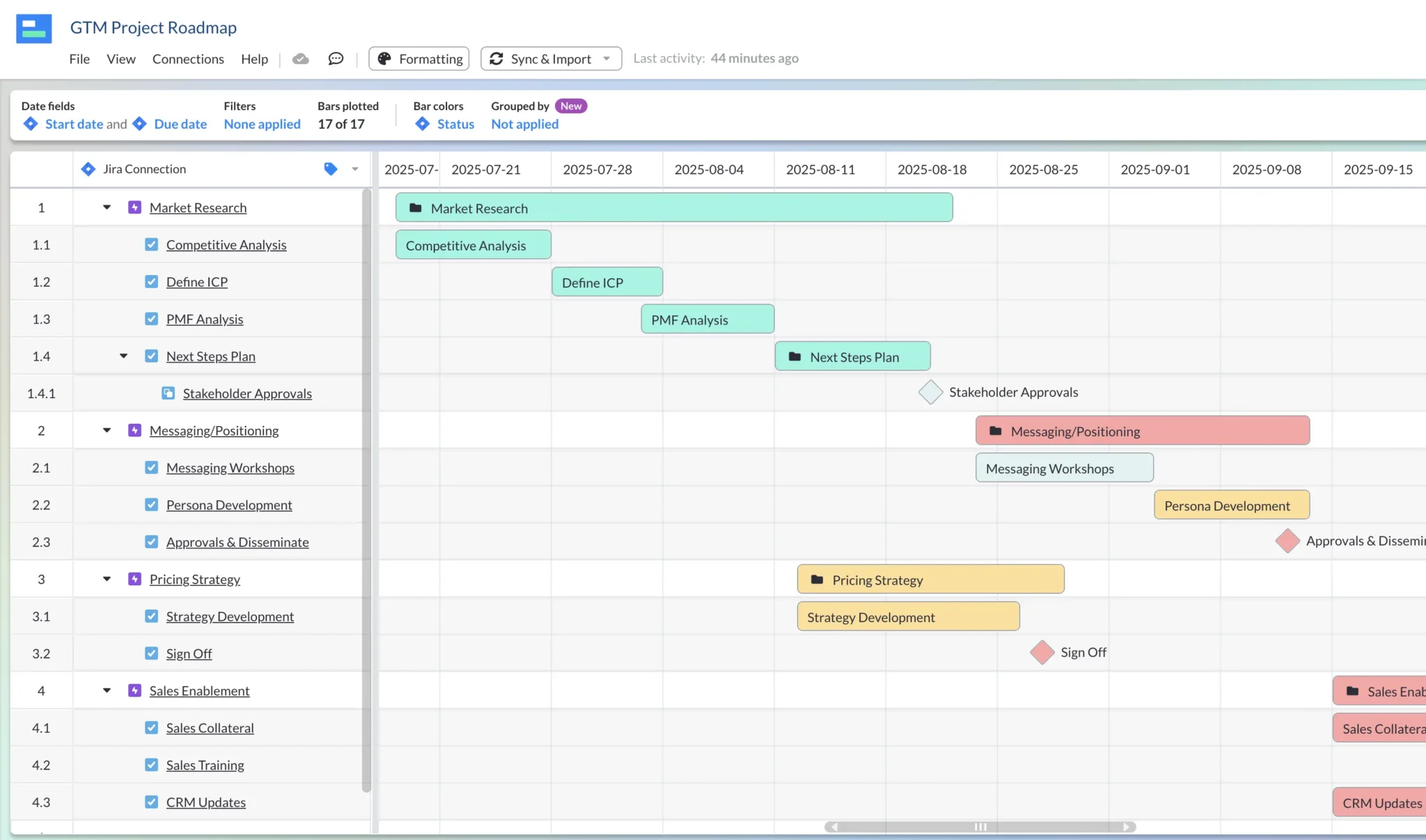
Example of a Capacity Planning Roadmap View
Here is a view of a project roadmap created in Visor, where tasks have been grouped according to assignee to make scheduling and capcity planning easier and mroe effective:
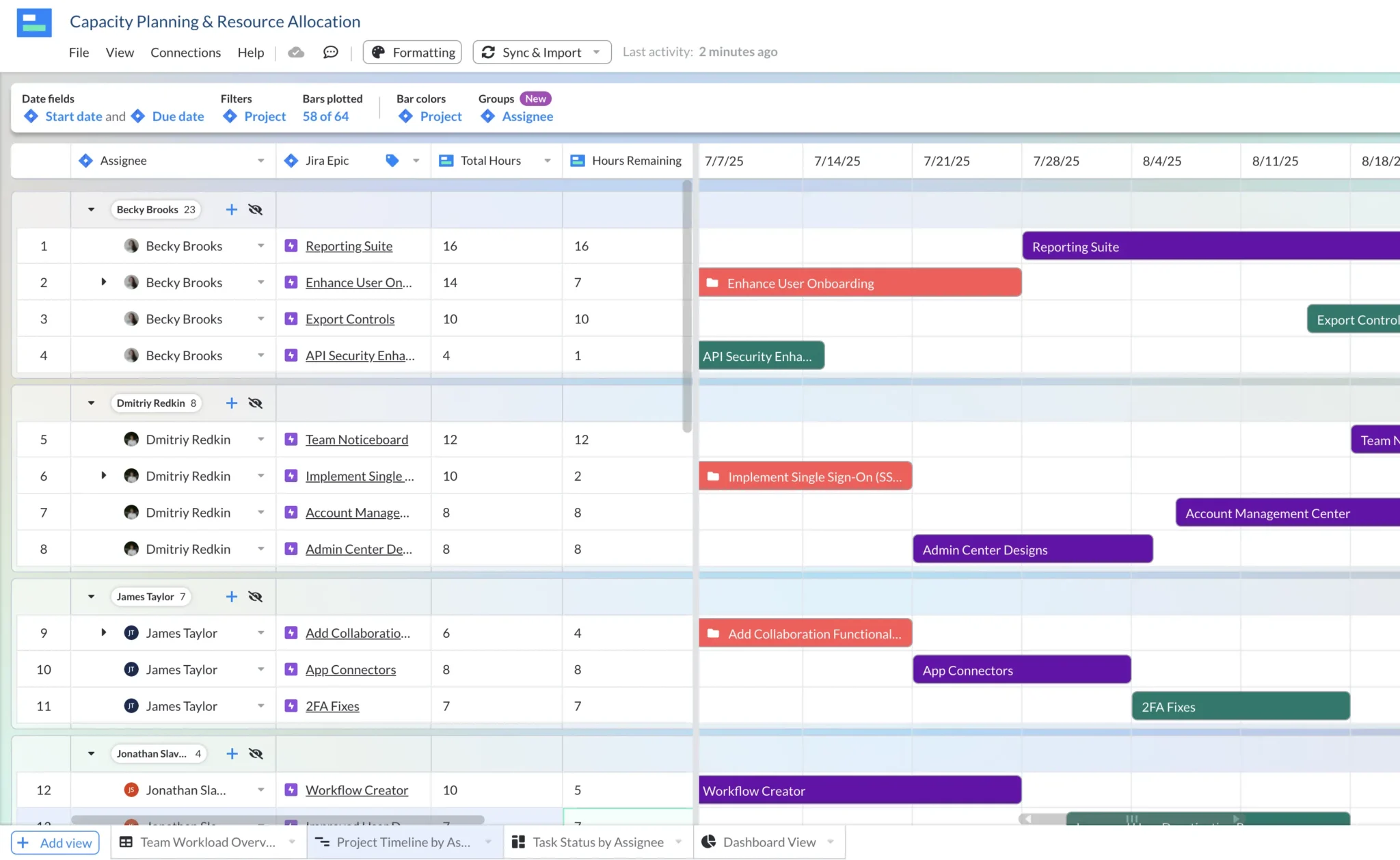
If you would like to create a similar view of your roadmap use this AI-powered capacity planning template from Visor.
Example of a Multi-Project Roadmap
There will be many instances where you need a roadmap that shows multiple related projects in the same roadmap. These groups of projects are called programs and are visualized on a program roadmap. You can find more information about program roadmaps in the sections below, plus examples of program roadmaps.
The example below is a multi-project roadmap for a program of marketing projects, with tasks grouped by the responsible team, and rollup calculations for parent tasks:
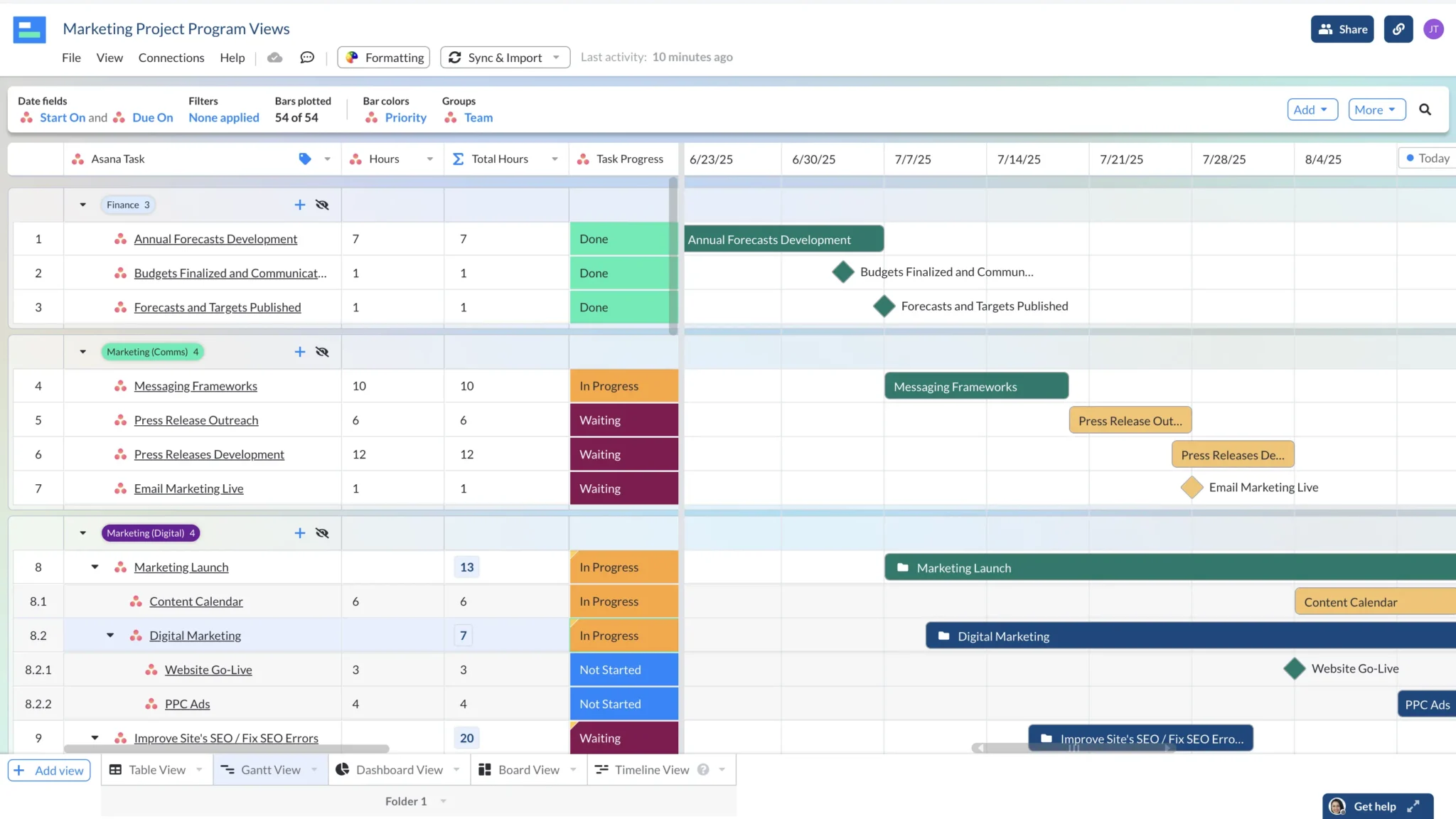
Example of a Simple Project Roadmap
Here is a simple project roadmap created in Visor using the Gantt chart view. The project data was pasted into Visor’s table view from a CSV and the Gantt chart was automatically created based on that data. The creator has added columns to show each task’s Assignee and On-Time Status:
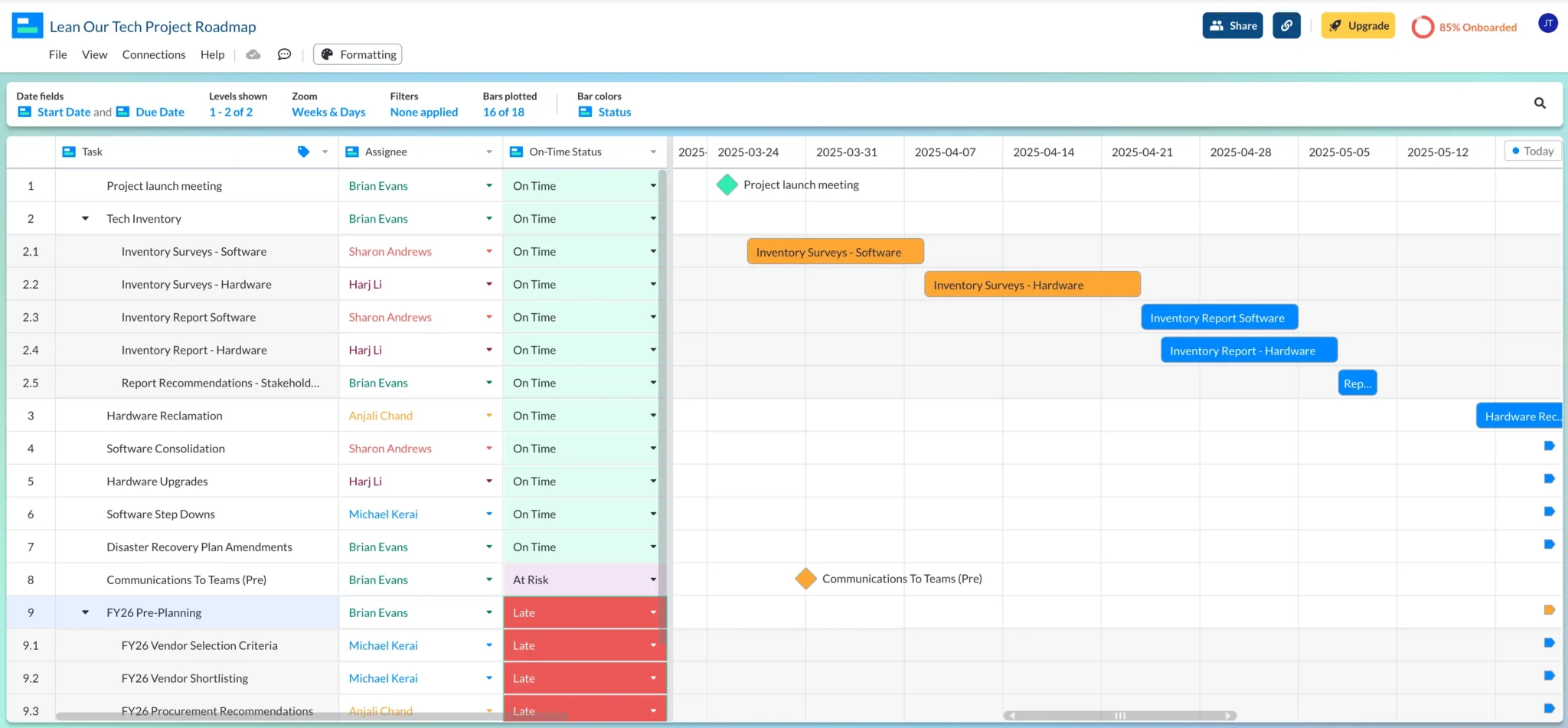
What common features do the best project roadmap examples share?
The best examples of project roadmaps share these characteristics:
- Color-coding: Colors indicate task status, assignee, priority, and other key details, allowing viewers to quickly ascertain this information at a glance.
- Milestones: Set key tasks or moments in the project as milestones, enabling them to be easily identified and, within an app like Visor, allowing users to filter the roadmap to show milestones only.
- Task Nesting: Subtasks are neatly nested below their parent task. Making it easy to see which subtasks belong to which parent tasks. In an app like Visor, you can expand or collapse nesting to change the level of detail shown —from high-level to granular—at any time.
- Columns With Key Details: In a Gantt chart, you can add columns to the left of the timeline section to show, change, and filter by additional task details, such as status, priority, assignee, etc. This makes your project roadmap richer and a living, working visualization that you can use to both track and update task details, such as assigning tasks to another person, changing due dates, or updating statuses.
- Grouping (optional): The ability to group tasks within a project by criteria such as assignee, status, priority, team, and others gives your roadmaps much more versatility. You can create specific views of your roadmap for specific people or purposes.
Here is a comprehensive guide on how to create best practice project roadmaps.
Templates for Project Roadmaps and Project Management
There are a wide range of templates you can use to save yourself time and begin with good foundations in place for your project roadmap: Project Roadmap Templates
In Visor you can use AI to create a “Smart Template” that is customized to your specific requirements and populated with your project data. This will save you even more time and effort by giving you a fully-formed custom project roadmap in a few minutes.
Here are some other AI-powered project management templates you can use:
- Project Gantt Chart Template
- Project Backlog Template
- Project Tracker Template
- Project Milestones Template
Which tools should you use to create project roadmaps?
All project management software has some form of roadmapping tool, typically enabling you to visualize, manage, and track your project plan in a basic timeline or Gantt chart format.
If you are already using project management software, your first step should be to try the timeline, Gantt chart, or roadmap feature in your existing software.
However, many users find these native (or built-in) tools lack important features. Users of these platforms will typically enhance native roadmapping capabilities by either:
- Using an app that integrates with their project management software and provides enhanced roadmapping features
- Upgrade to a higher-tier plan to unlock enhanced roadmapping features
For example, people use Visor as a Jira roadmapping tool. It enables Jira users to overcome the limitations of Jira’s built-in roadmapping functionality, including the Premium-level Advanced Roadmaps feature.
How can I create a project roadmap without project management software?
If you are not using project management software, then you can create a Gantt chart-style roadmap in Google Sheets or an alternative spreadsheet-type software.
Program Roadmaps & Portfolio Roadmap Examples
Program roadmaps and project portfolio roadmaps both involve visualizing multiple projects on a single roadmap with a unified timeline; however, they have important differences, which I explain below.
If you already understand these differences, please scroll down to the sections for Program Roadmap Examples and Portfolio Roadmap Examples.
How do project, program, and portfolio roadmaps differ?
Project roadmaps, program roadmaps, and portfolio roadmaps are distinct because project management, program management, and portfolio management are related yet distinct practices. Here is a summary of each of them:
- Project management: The management of a single, distinct project
- Program management: The collective management of a group of related projects that support the same objective or goal, with a focus on balancing shared resources and optimizing performance across those projects
- Project portfolio management (PPM): The management of all an organization’s programs and projects, with a focus on selecting and tracking projects to ensure they support the organization’s strategic goals and deliver a positive return on investment
These variations of focus and purpose shape the differences between each type of roadmap:
- Project roadmaps: Show a single project with a high level of detail. They help a project manager to plan a single project and ensure on-time completion.
- Program roadmaps: Show multiple projects from the same program in a single roadmap, with a mid-high level of detail (typically parent tasks and initiatives, not subtasks). Program roadmaps help users to balance resources and interproject dependencies across a program.
- Portfolio roadmaps: Show all of an organization’s projects and programs at a very high level. Portfolio roadmaps help users to see when full initiatives will start and end and typically display other information such as spend/overspend, ROI, total story points, or hours.
Program Roadmap Examples (40)
Here are some high-quality examples of program roadmaps that I created in Visor. Some use data from multiple projects from project management apps that integrate with Visor (such as Jira and Asana).
Example of a Program Roadmap With Calculated Rollup Fields
Here is an example of a program roadmap created in Visor, using real-time Jira data. Only the epic level of Jira issue type is shown, note the calculated rollup fields for Total Story Points and Average Story Points for each epic:
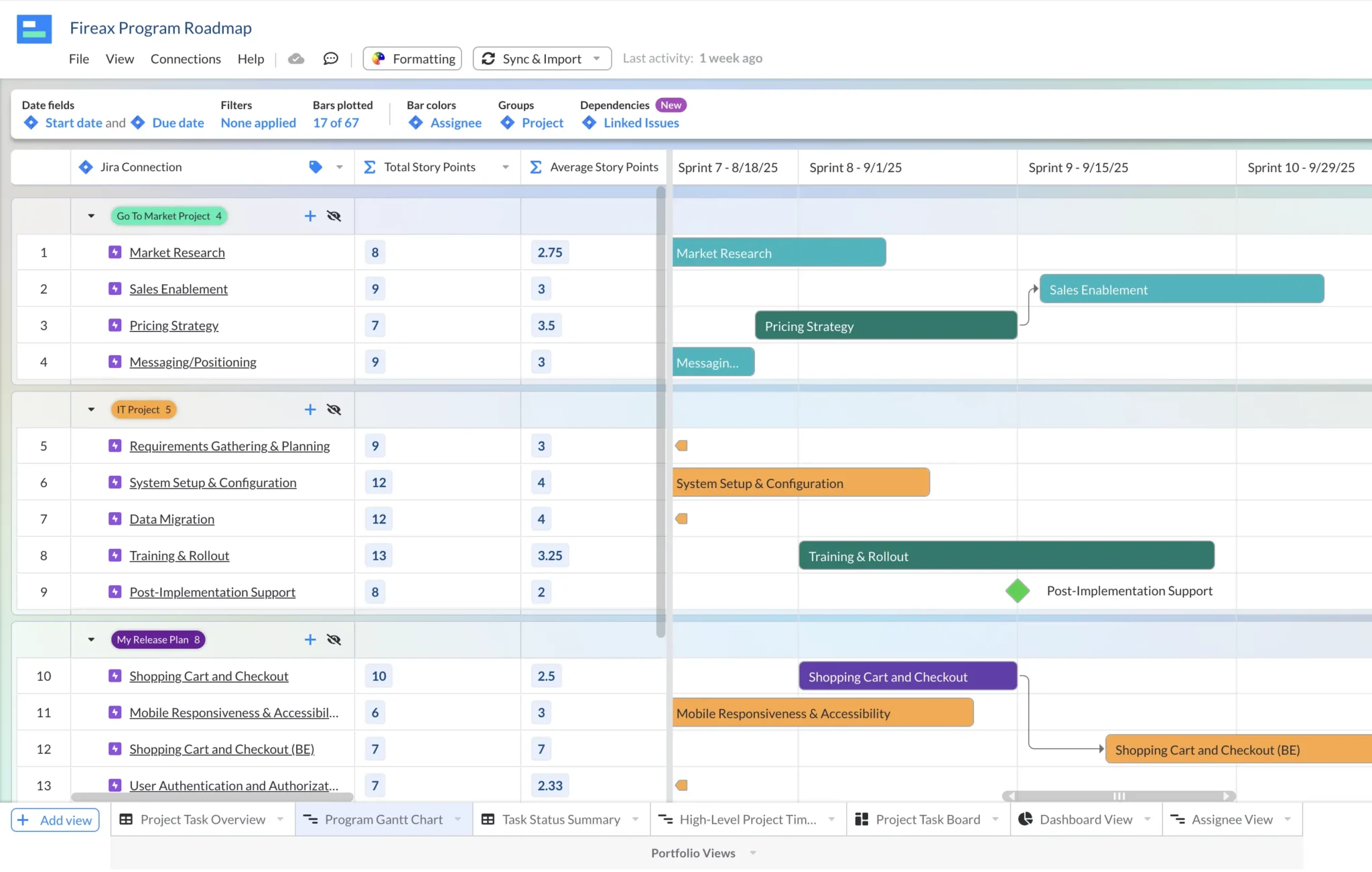
Example of a Program Roadmap With Subtask Details Shown
Here is a program roadmap created in Visor and the user has expanded some of the epics to show their tasks and subtasks, note the cross-project dependencies (Jira issue links) and color-coding based on issue status:
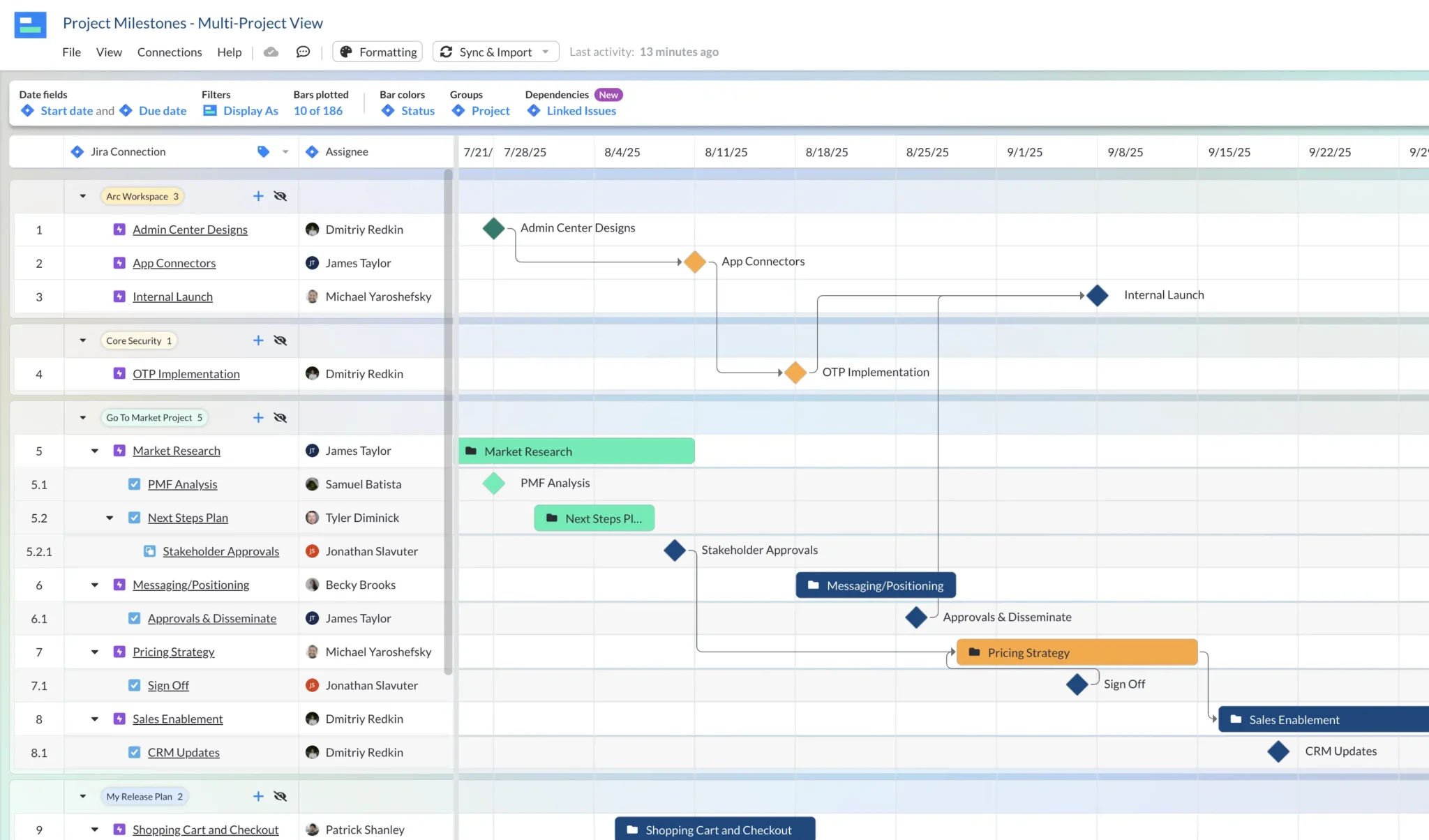
Should I use project management software to create product roadmaps?
Most project management tools do not fully support users in creating program roadmaps because their purpose is to enable users to manage single projects as separate units.
Some project management tools offer basic program management functionality, but this is often so limited that it typically prevents users from creating program roadmaps that are both usable and useful.
Most people will eventually use program management software like Visor, which integrates with existing project management software, to close their program management and roadmapping functionality gaps. This enables them to create real program roadmaps while keeping their existing project management tool.
What are the best tools to create program roadmaps?
The best tools to manage multiple projects will enable you to create visualizations like roadmaps, timelines, dashboards, and Gantt charts with multiple projects.
They also enable you to construct your programs by grouping projects and tasks on a range of criteria, such as project, initiative, team, program, priority, status, and so on.
For example, people often use Visor with their existing project management software, such as Jira or Asana, in order to add a valuable layer of program management functionality, which improves their ability to create program roadmaps and dashboards and manage programs and their performance.
To save yourself time and effort, get a custom project roadmap that is infused with best practices in minutes by using Visor’s AI-powered program roadmap templates.
Portfolio Roadmap Examples
Here are some high-quality examples of portfolio roadmaps that I created in Visor. Some use data from multiple projects and programs from project management apps that integrate with Visor (such as Jira and Asana).
Example of a Portfolio Roadmap With Additional Columns For Rice Scoring and Status
This robust example of a project portfolio roadmap shows multiple projects and their epics with an additional column for a RICE score that was used to assist with prioritization. The Gantt bars are color-coded based on issue status:
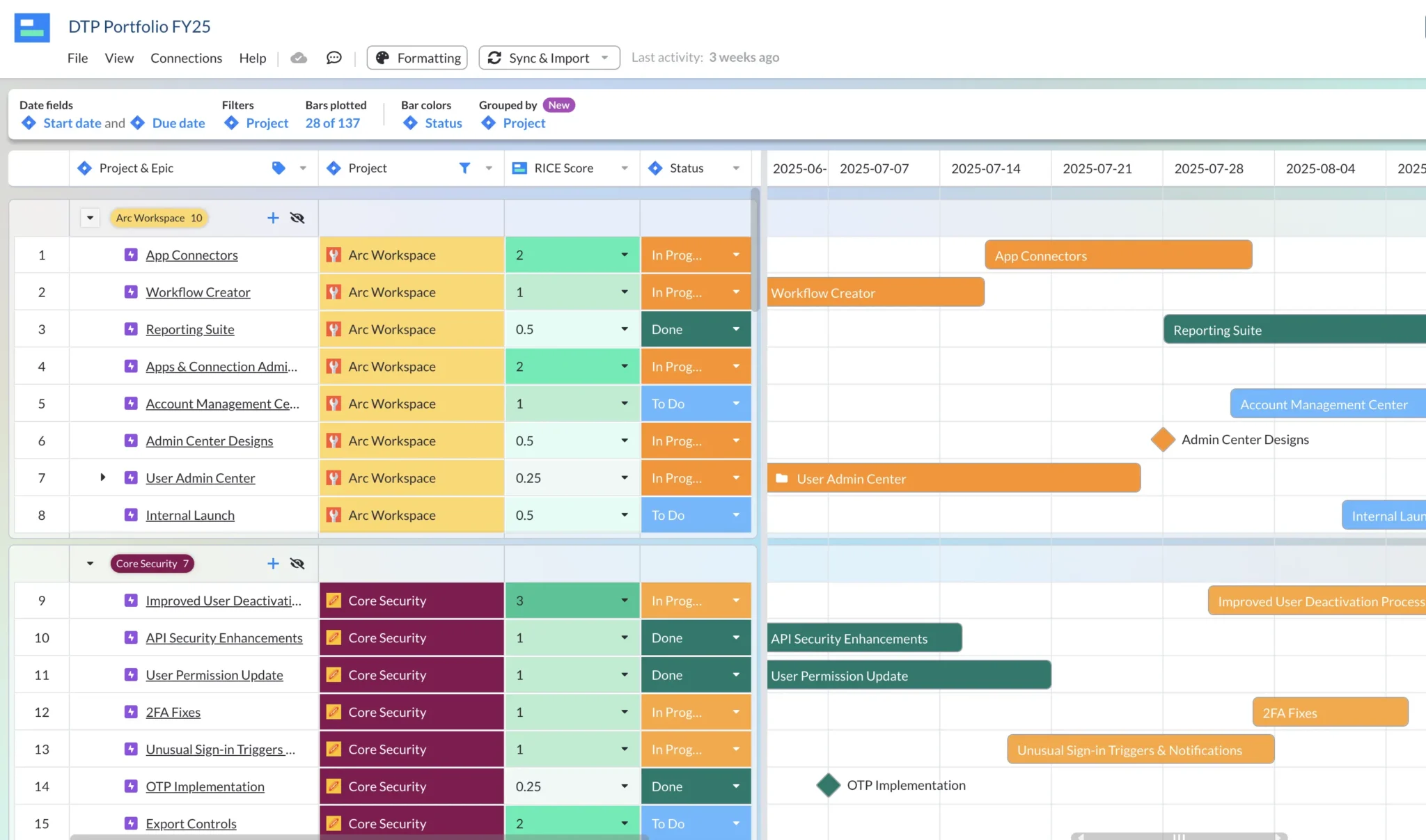
Example of a Portfolio Roadmap With Varied Grouping
The two images below show the same portfolio roadmap but each uses a different field to group the tasks/issue types on the roadmap (which includes epics and features – a custom Jira issue type).
The alternate grouping enables teams to view the roadmap from the angle of project, or project manager at any time, without applying complex filters or creating a brand new roadmap.
These roadmaps were created in Visor which enables you to group records based on any dropdown field, and save multiple, synchronized versions of your roadmap, so that you can keep a “Project Manager View” and a “Project-Based View” of your portfolio roadmap. Both roadmaps stay up-to-date with any changes as they are synchronized, preserving your single version of truth:
Grouped by Project:

Grouped by Project Manager
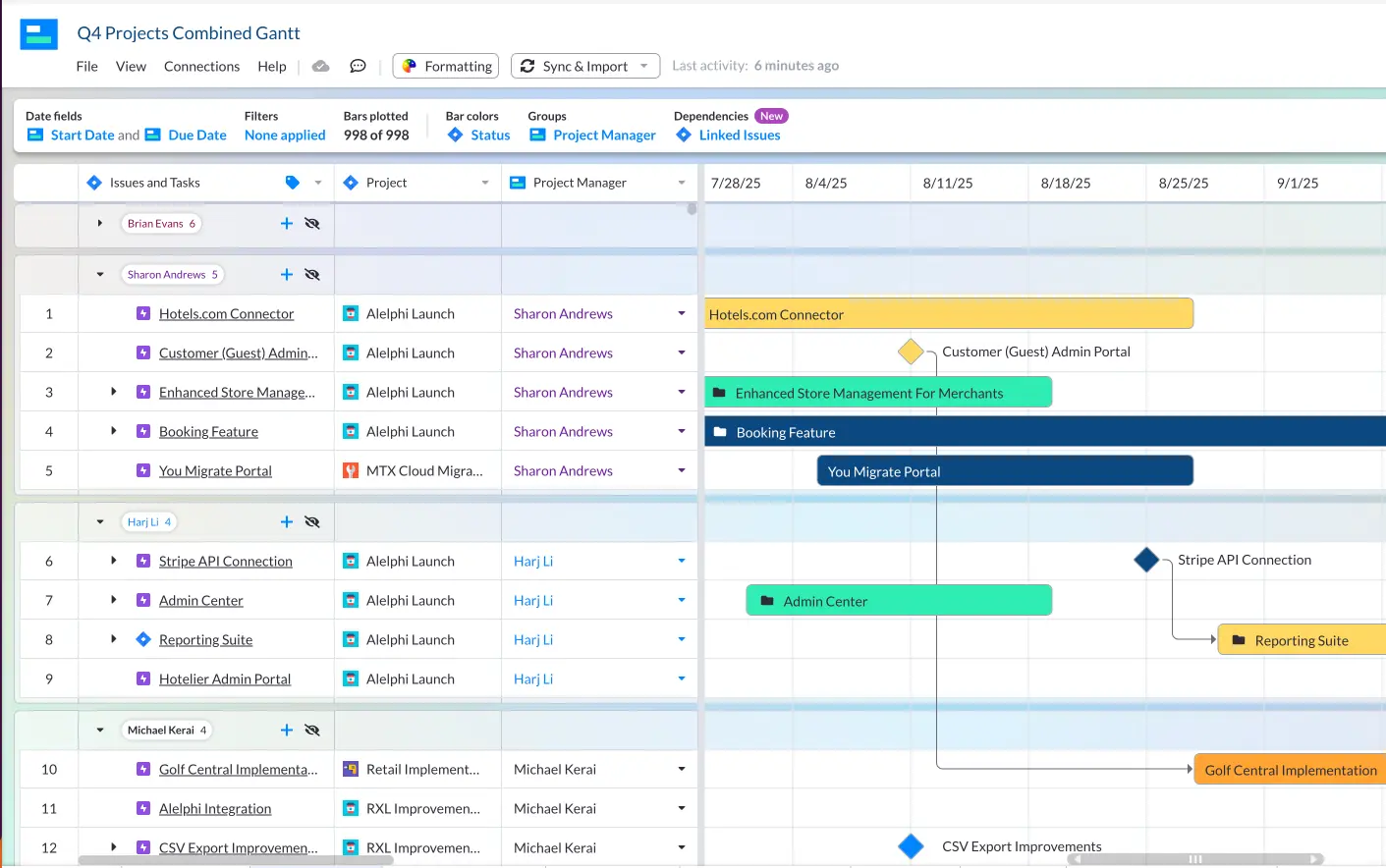
Example of a Portfolio Roadmap Using Asana Data
The example below shows a portfolio roadmap in Visor, with real-time data from multiple Asana projects. The roadmap is grouped by the Team field (to group tasks based on who is responsible for them), and there is a calculated rollup field for Total Hours per parent task:

Can I use project management software to create portfolio roadmaps?
Many project management tools offer some form of portfolio management functionality, typically as part of their highest-tier plans. However, this functionality always has significant gaps and limitations that prevent users from creating project portfolio roadmaps and effectively managing their project portfolios.
For example, Asana is one of the most popular project management apps, and it includes a Portfolios feature as part of its Advanced Plan, which starts at $30.49 per user per month.
However, Asana’s Portfolio feature has numerous limitations, which I’ve covered in depth in this article on Asana roadmaps and this article on Asana’s Gantt chart view.
What software is best for creating portfolio roadmaps?
Most people use an additional app on top of their project management software to provide portfolio management capabilities; for example, Asana users frequently use Asana-integrated Gantt chart tools like Visor or Instagantt.
Until recently, PPM software was too expensive and complicated for most organizations, as it was an enterprise-level-only solution. However, the best PPM software is increasingly modern, easy to use, and flexible, like Visor’s PPM solution.
This shift in the quality, affordability, and ease of use of PPM tools means that small to mid-size businesses now have viable alternatives to Microsoft Project and Smartsheet, offering feature parity in a better-scaled, easier-to-use, and more competitively priced tool.
Where can I find the best templates for portfolio roadmaps?
There are many templates available online from software vendors and experienced portfolio managers sharing their work.
You can use Visor’s AI Smart Templates for project portfolio management to create a custom, best-practice portfolio roadmap for you in minutes, along with other visualizations like a Table view to help you organize and manage your portfolio of projects.
Strategic Roadmaps
People sometimes use the term strategic roadmap to refer to project portfolio roadmaps (see the section above for more details on portfolio roadmaps).
However, strategic roadmaps and portfolio roadmaps each serve a different purpose, but are complimentary, somewhat interdependent, and together help form the most robust strategic planning and execution processes.
What is a strategic roadmap and how does it differ from a portfolio roadmap?
A true strategic roadmap is different from a project portfolio roadmap. A strategic roadmap enables a strategic planning team to map out:
- The Organization’s Vision: Where and/or what does the organization want to be by a set date
- Strategic Objectives: What the organization needs to achieve to realize its vision
- Strategic Initiatives: The large-scale initiatives the organization needs to plan and complete to achieve its strategic objectives
- Strategic Milestones: The milestones that need to be hit as part of the strategic initiatives and to ensure the achievement of the strategic objectives
- Timeline (optional): Showing a high-level timeline (usually using quarters or months) when the team expects to complete each strategic initiative and milestone
- Initiative Owners: Who is responsible for the overall planning and delivery of each initiative
A strategic roadmap enables an organization to set its vision and create a high-level plan to achieve that vision without detailing the specific projects that will be part of the strategic initiatives.
A strategic roadmap enables those responsible for project portfolio management and the creation of the portfolio roadmap to:
- Define which programs and projects should be selected (those that align with the strategic objectives, initiatives, and organizational vision)
- Schedule programs and projects according to the timeline and milestones for strategic initiatives
- Prioritize and distribute budgets/resources to programs/projects
- Define success criteria and KPIs for programs and projects in the portfolio
This table summarizes the main differences between strategic roadmaps and project portfolio roadmaps:
| Strategic Roadmap | Portfolio Roadmap | |
| Usual Format | A. Table view with columns for Vision, Objective, Initiative, Milestones, and Owners. B.High-level timeline view with outline dates (such as quarters), strategic milestones, and swimlanes for strategic objectives. | High-level Gantt chart/timeline – see examples of portfolio roadmaps above |
| Purpose | Planning the strategy and key initiatives that will enable the organization to achieve its vision. | Track project and program delivery and performance. Manage cross-project dependencies, plus resource demands and allocations. |
| Author/Creator | Senior leadership (C-suite), specific strategy teams | Project management office team/portfolio manager/senior project manager |
Should I create a strategic roadmap and a portfolio roadmap?
Yes, a strategic roadmap and a portfolio are neither the same thing nor mutually exclusive; they are complementary.
A strategic roadmap enables you to plan and demonstrate your organization’s vision and how you will achieve it through a strategy, complete with initiatives, their owners, and key milestones.
A project portfolio roadmap outlines the timeline for the projects you have chosen and planned to complete, aligning with your strategy to achieve strategic objectives and realize your organization’s vision.
Therefore, strategic roadmaps and project portfolio roadmaps are interdependent and essential components of a comprehensive strategic planning and execution process.
The strategic roadmap sits above the portfolio roadmap, helping to define which projects and programs should be planned and/or selected and determining the success criteria for those projects and programs, as well.
IT Roadmap Examples
Here are two examples of IT roadmaps, the first covers an internal IT project for the selection and implementation of a new IT system:

The second example of an IT project roadmap below is used to plan and track IT implementations for enterprise clients, using a mix of real-time data from Jira and from Salesforce, to help collaboration between account management, customer success, and IT system implementation teams:
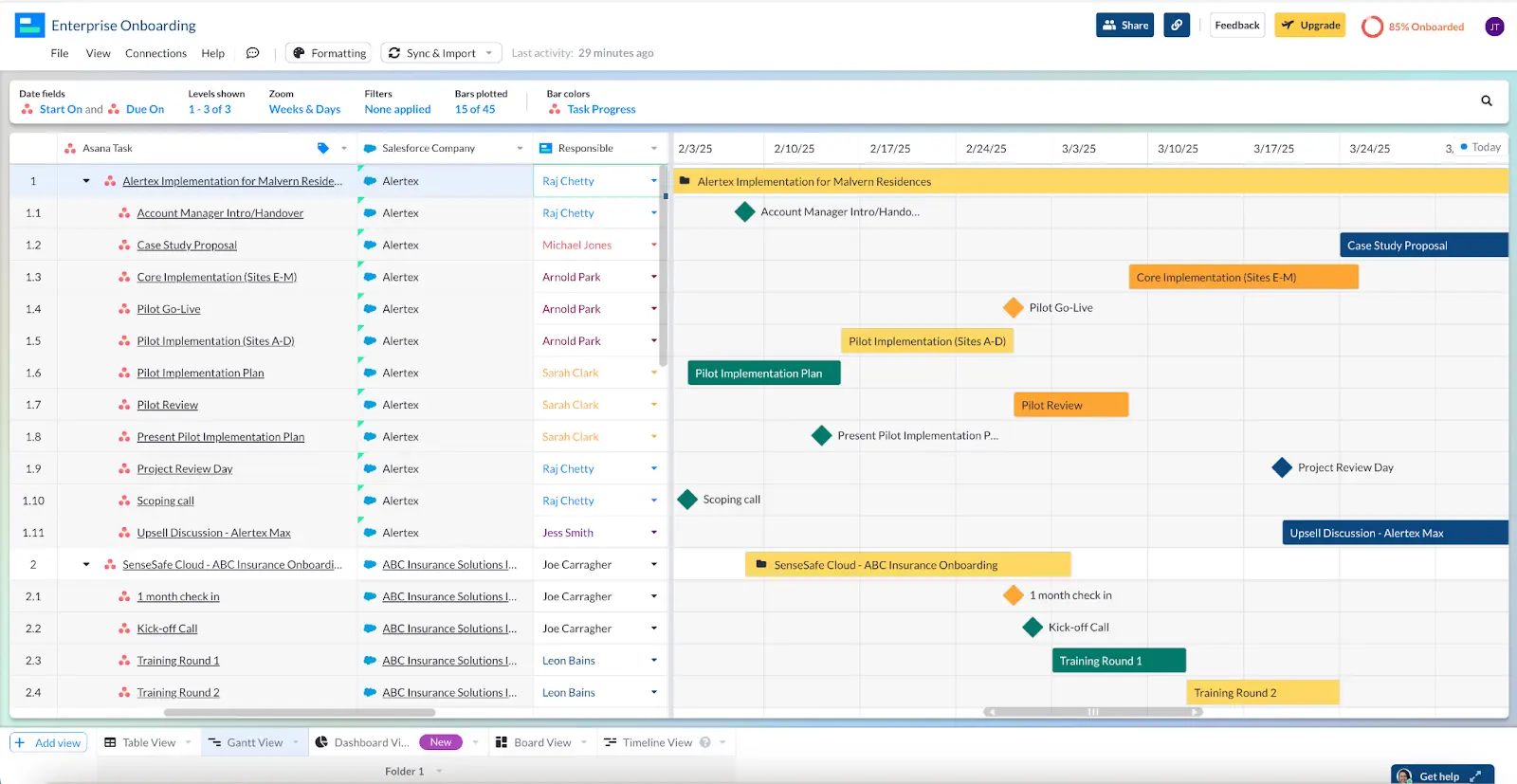
What type of roadmap do agile teams use?
Traditionally, agile teams have been averse to using the typical linear Gantt and timeline roadmap formats, as these formats conflict with the core principles of the agile methodology, which emphasize avoiding strict deadlines, due dates, and rigid schedules.
Most agile roadmaps use a Kanban board with columns for “Now,” “Next,” and “Later,” or similar flexible categories. The key is to provide some form of schedule and priority without using a rigid schedule with due dates.
However, agile teams still use Gantt chart and timeline versions of their roadmap for several reasons, including:
- Sharing a scheduled view with stakeholders
- Creating high-level views such as “epic roadmaps” that outline completion timelines for epics and/or initiatives
- Prevent risks by ensuring tasks and projects with large or competing demands on resources do not overlap
- Visualize and understand dependencies between tasks within projects and across different projects
- Making resource allocation easier
- Planning and coordinating sprint schedules
For these reasons, more mature agile teams will use a combination of Kanban-style roadmaps with timeline/Gantt linear roadmaps to plan, track, and share their initiatives and projects. They may even use an agile portfolio management tool to create roadmaps that show all their projects in a program or portfolio.
Agile Roadmap Examples
Here are some examples of agile roadmaps, featuring a mix of Kanban-style and timeline/Gantt chart-style roadmaps to help you create and improve your agile roadmaps.
Example of a Simple Kanban Now, Next, Later Roadmap:
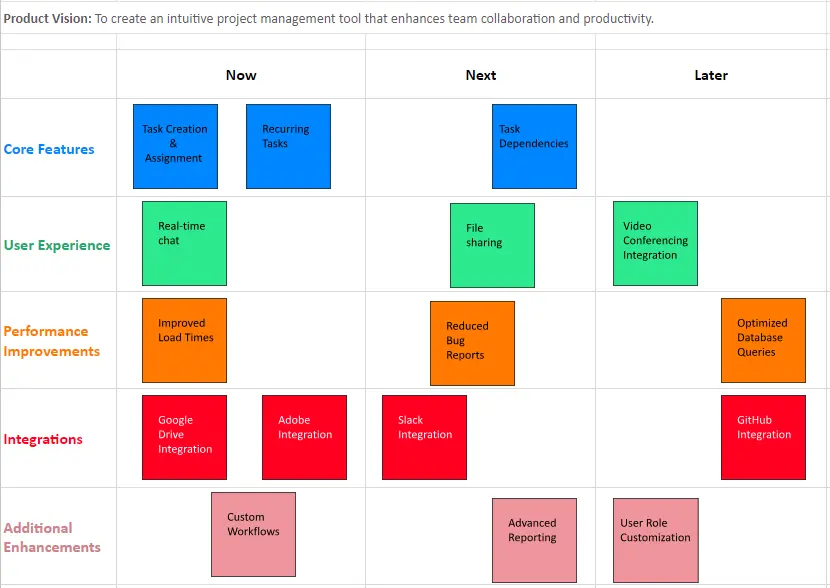
A Kanban Roadmap/Tracker Using Real-Time Jira Data:
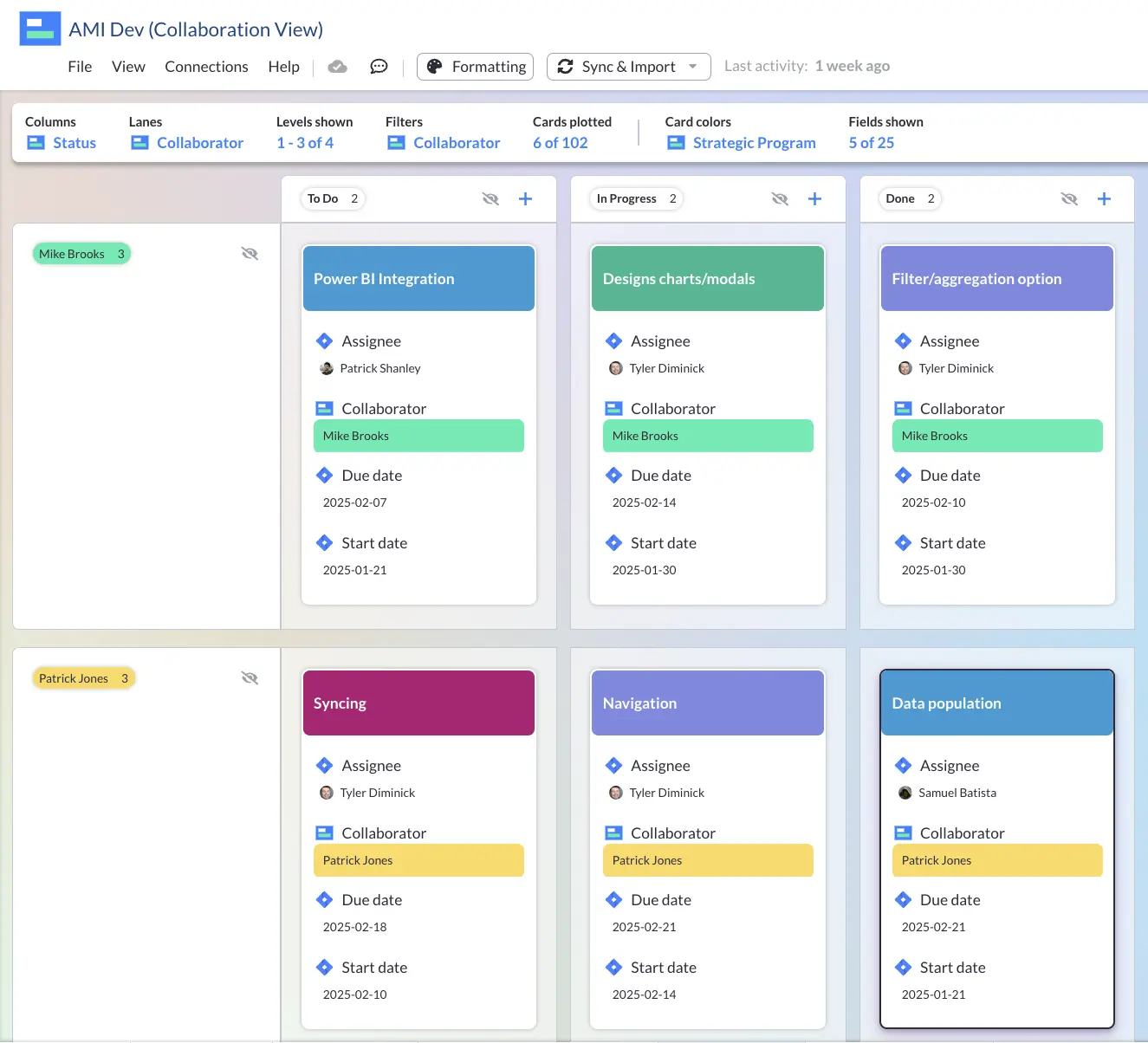
Example of an Agile Roadmap in a Gantt Chart Format
Here’s an example of an agile roadmap in a Gantt chart format created in Visor using this agile roadmap template. It has real-time Jira data and tasks are grouped by “Strategic Initiative”:
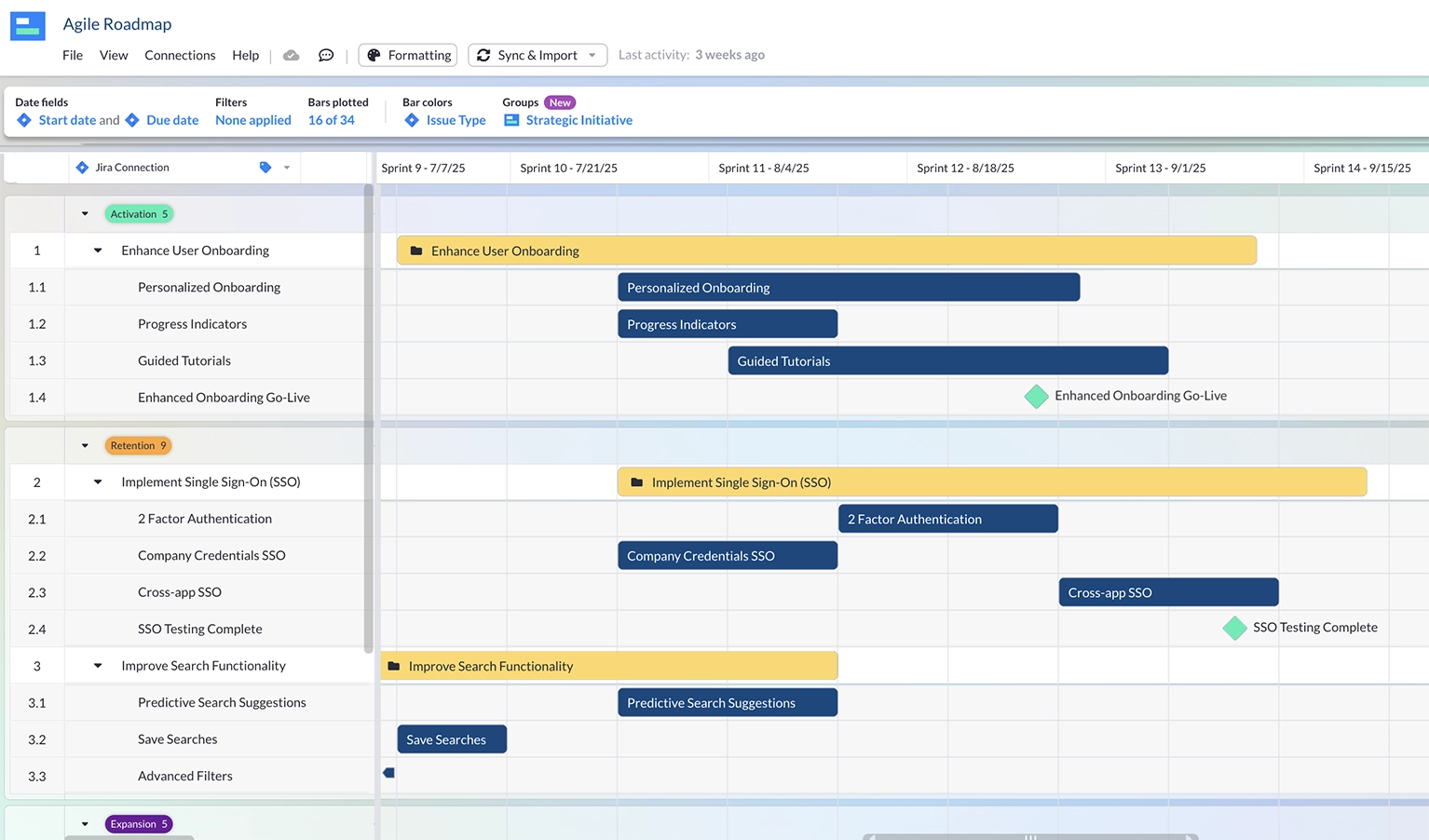
Additional Agile Visualization Examples and Templates To Compliment Your Roadmaps
Here are some additional examples of agile visualizations you can use alongside your roadmaps. For each visualization there is a link to a page with templates you can use to create your own visualization too.
Also link to: https://www.visor.us/templates/agile-gantt-chart-template/
Agile Release Plan
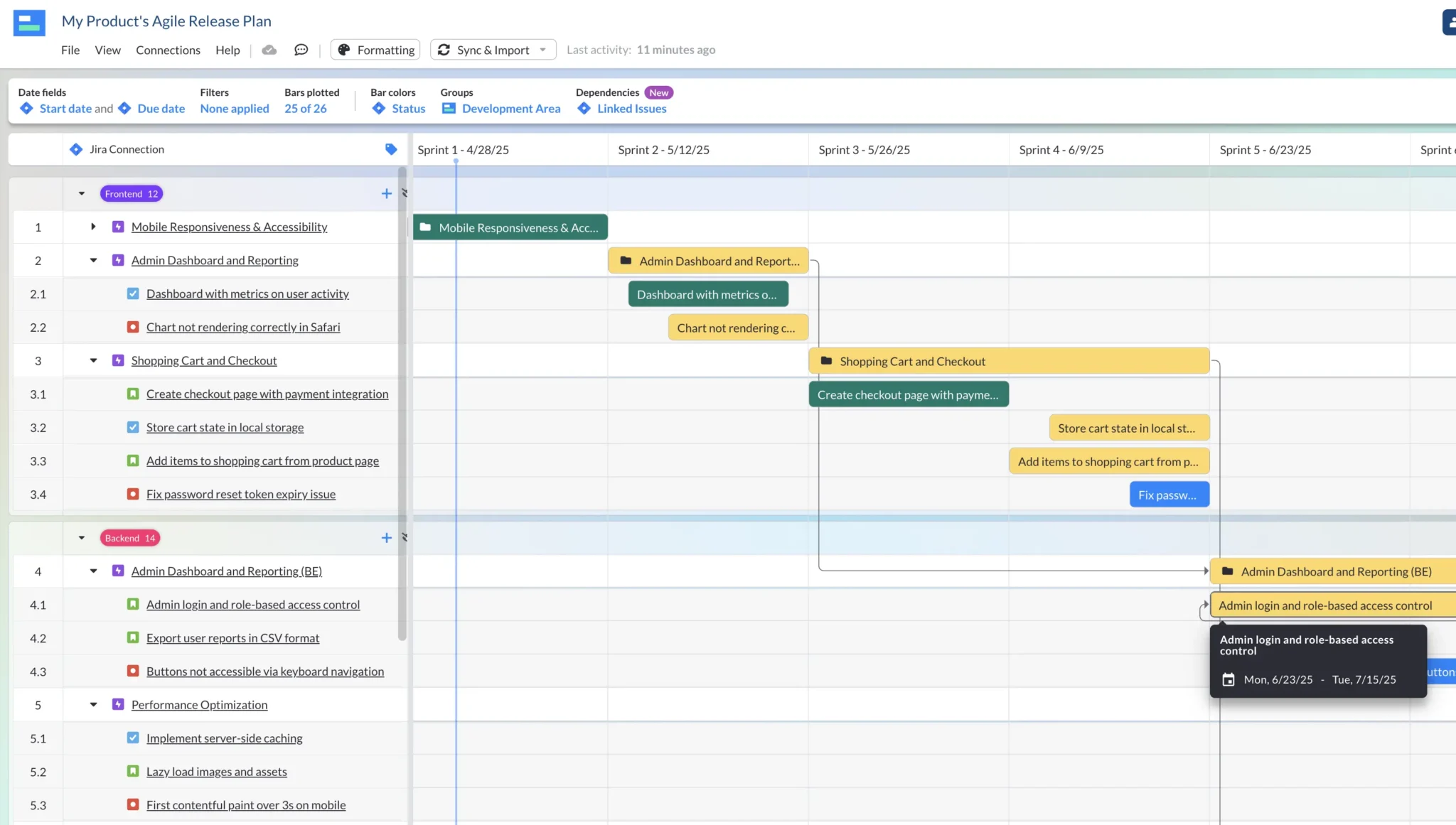
Created in Visor using this AI-powered agile release plan template with my real-time Jira data.
OKR Tracker
A task tracker in a Gantt chart grouped by OKR:
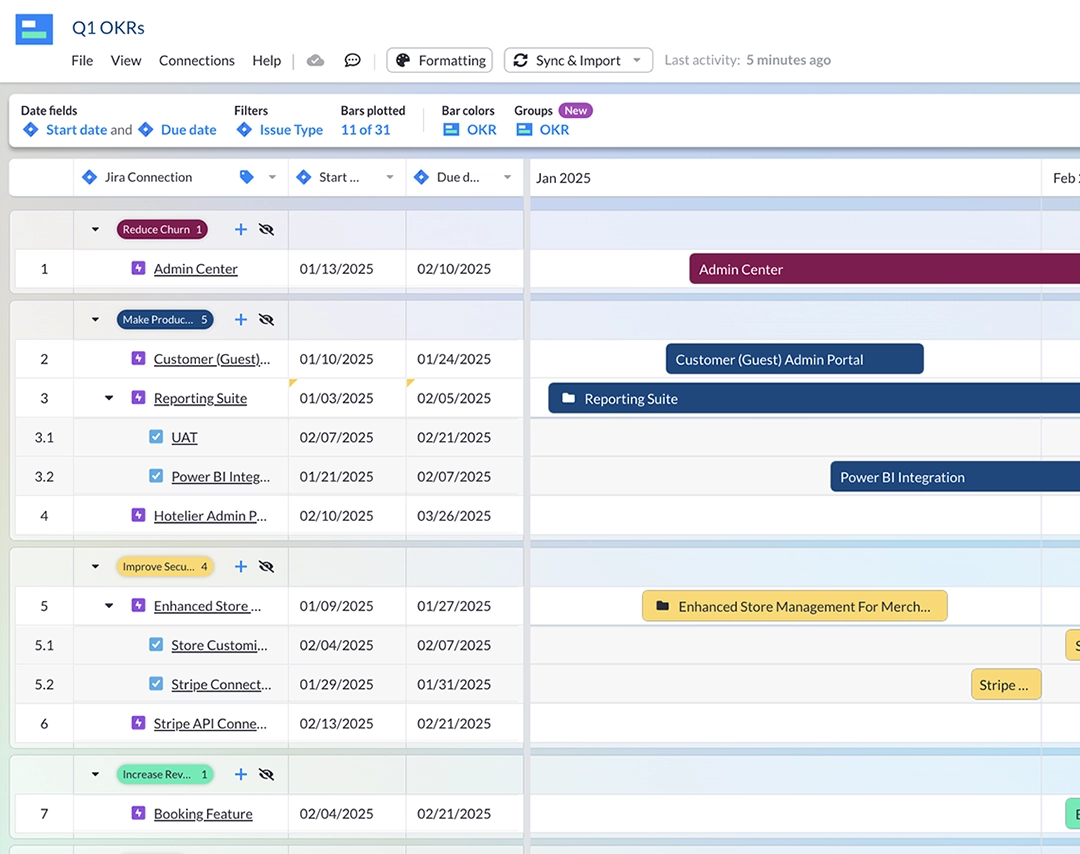
This view was created using this AI-powered template for OKR tracking in Visor, it uses real-time Jira data and shows detail down to the subtask level.
Sprint Backlog
Here’s a sprint backlog Kanban board created in Visor using this AI-powered sprint backlog template and real-time Jira data:
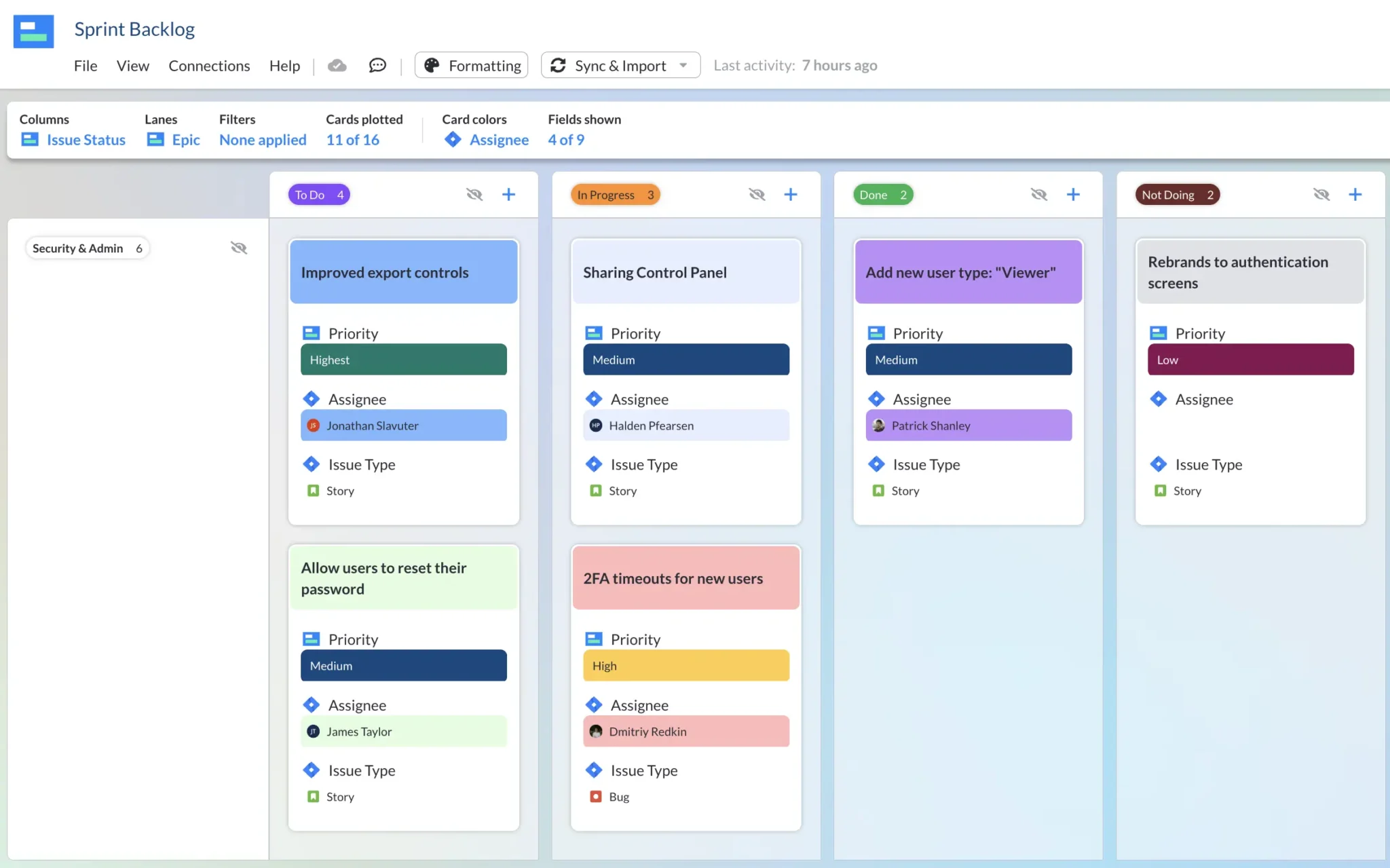
Sprint Retrospective
Here’s a sprint backlog Kanban board created in Visor using this AI-powered sprint retrospective template and real-time Jira data:
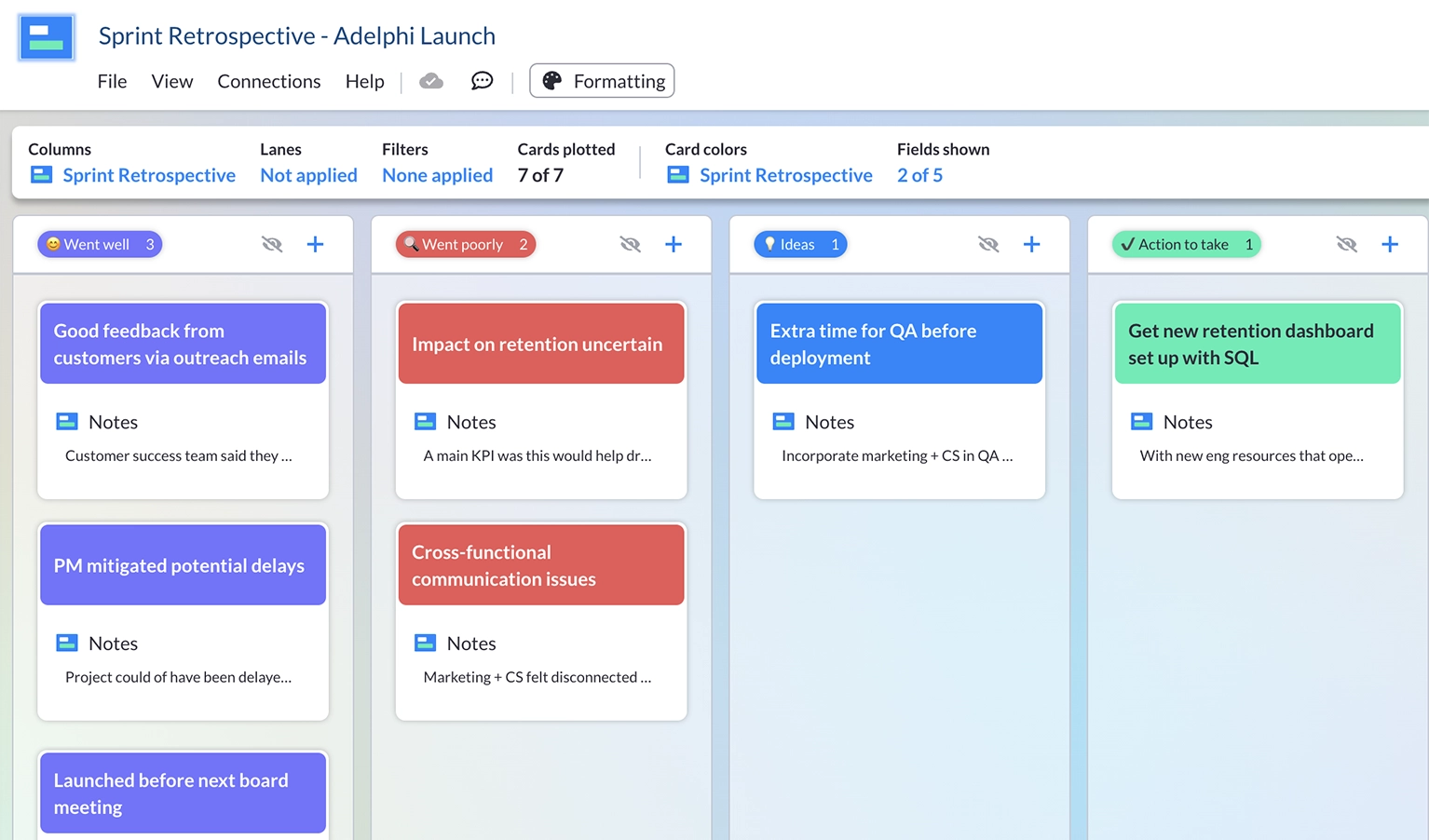
Marketing Roadmap Examples
Here are some great examples of marketing roadmaps for a range of marketing projects and programs. All of these examples of marketing roadmaps were created in Visor, learn more about Visor for marketing teams.
A simple marketing project roadmap with tasks grouped by the priority field:
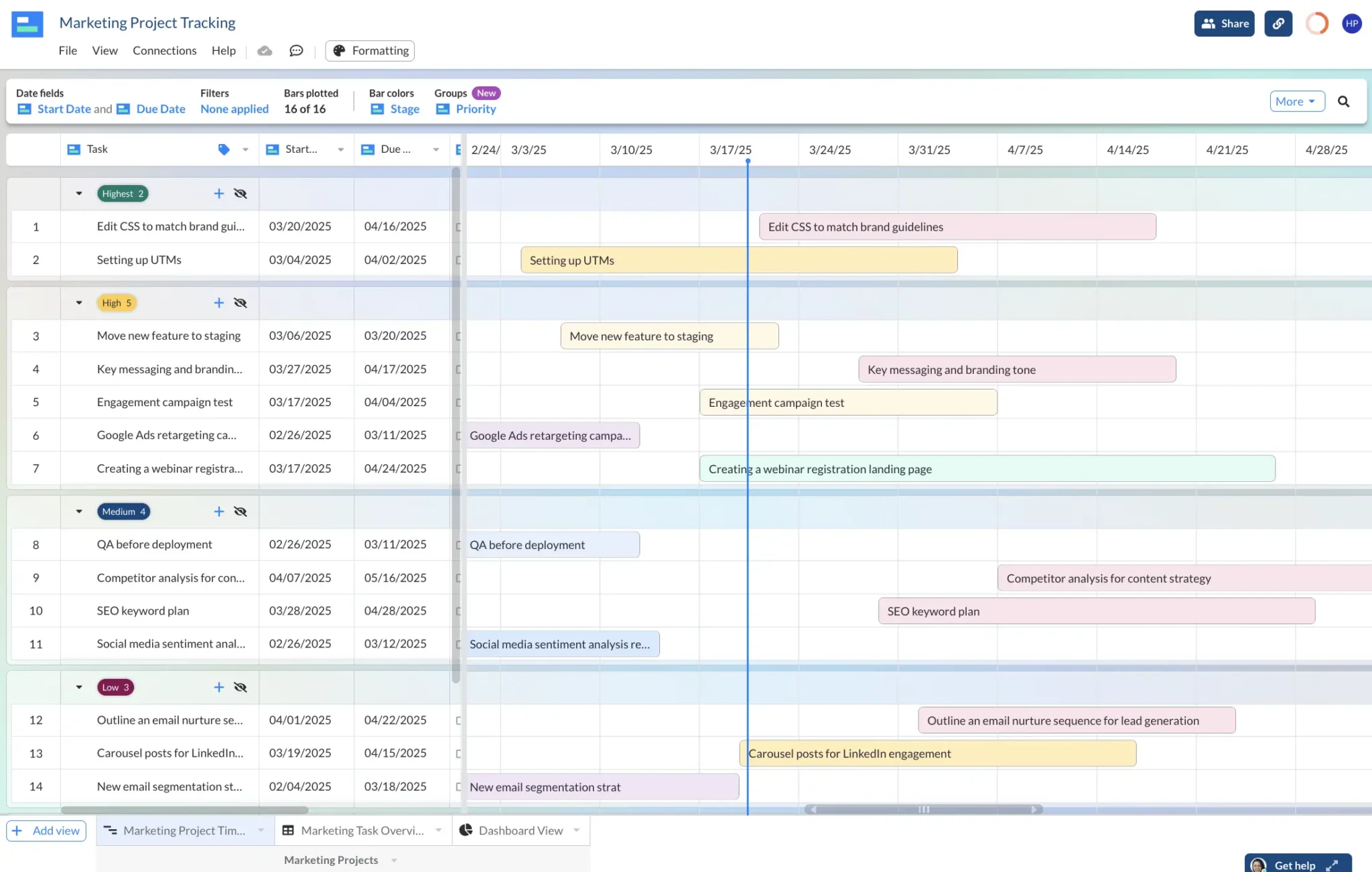
A simple Kanban-style roadmap for marketing content planning and tracking:
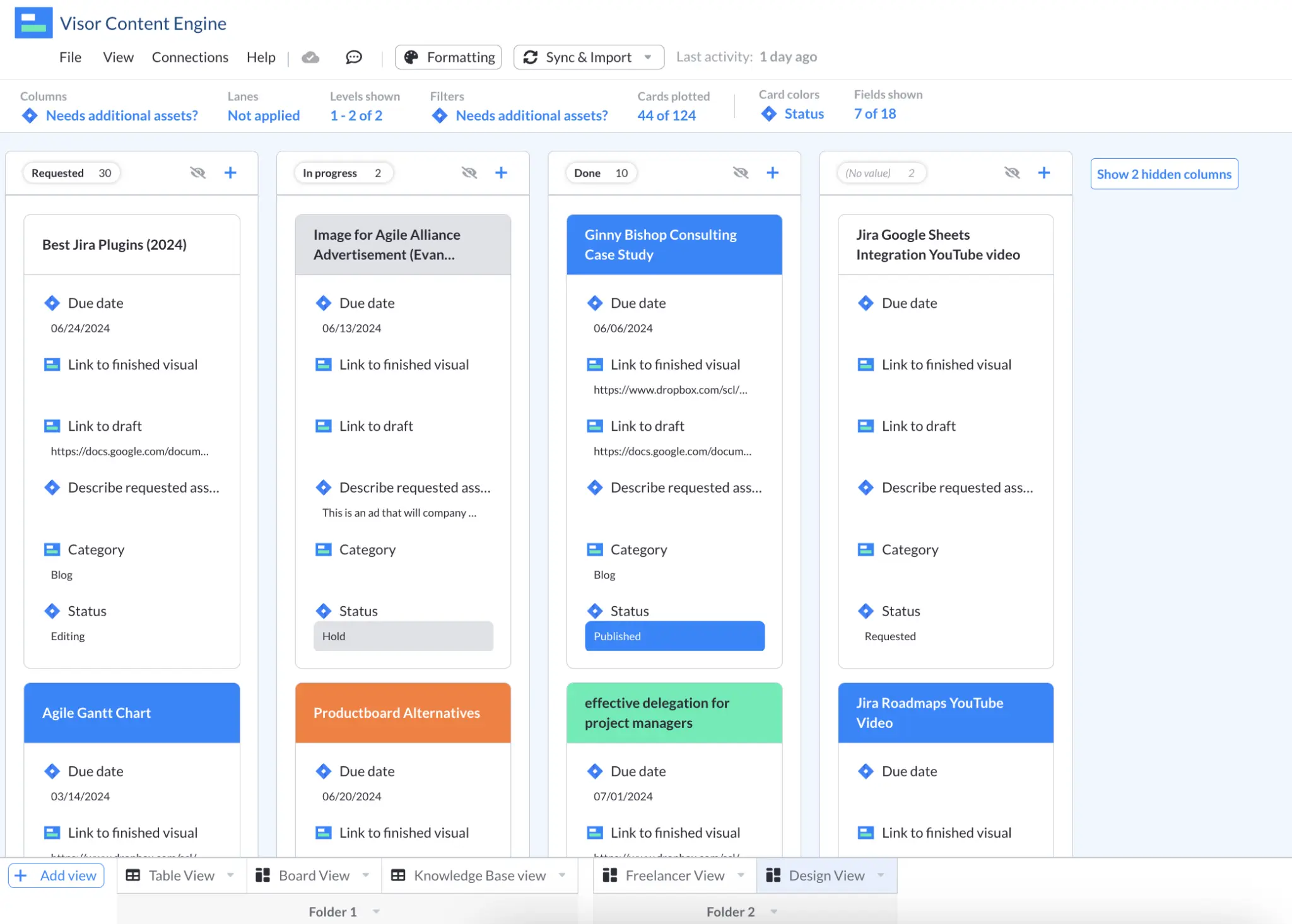
Closeup example of a roadmap showing digital marketing tasks as part of a product launch:
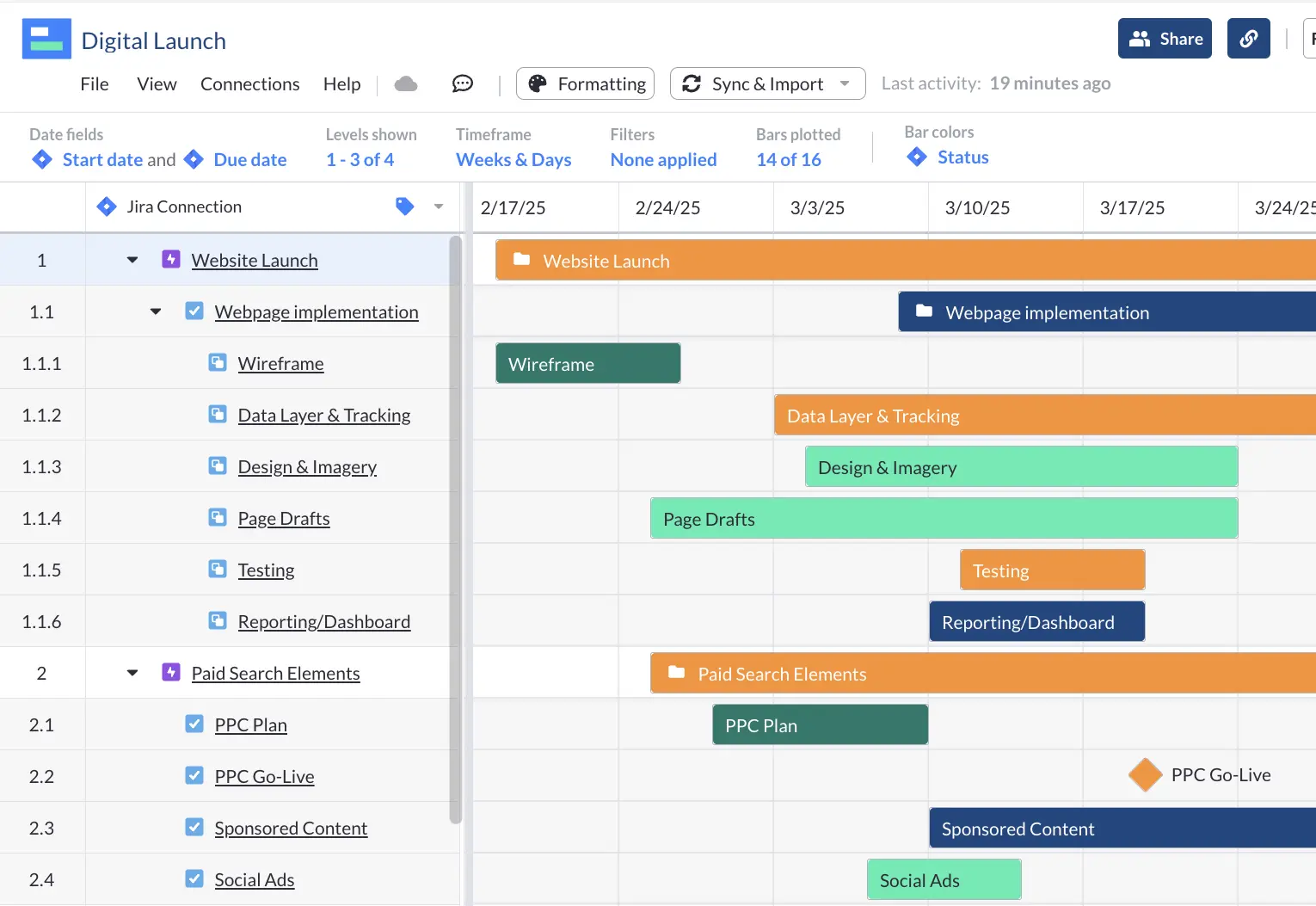
Using These Roadmap Examples To Create Better Roadmaps
No two roadmaps are exactly the same but the examples shown here alongside the additional information give you clear guidelines you can use to create better roadmaps regardless of the scale or objective of your projects, programs, or portfolios.
To help you get started faster, use Visor’s AI Smart Template technology. Visor’s AI will create a bespoke set of visualizations for you in a few minutes based on your project data’s characteristics and the additional prompts you give it. This will save your team hours each time they need to create a roadmap.
Plus, your roadmap templates benefit from best practice the AI’s has gathered by analyzingthousands of user-created roadmaps in Visor.
Visor is powerful, easy-to-use software that you can use to create roadmaps, Gantt charts, and other visualizations for any purpose. Visor has two-way integrations with apps like Jira and Asana too, making it your perfect parter to make better project, program and portfolio roadmaps, with your real-time data from your existing project management app.




